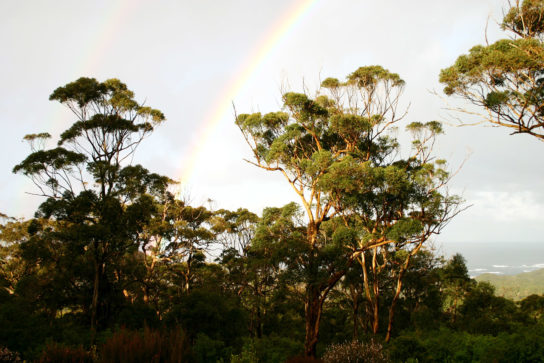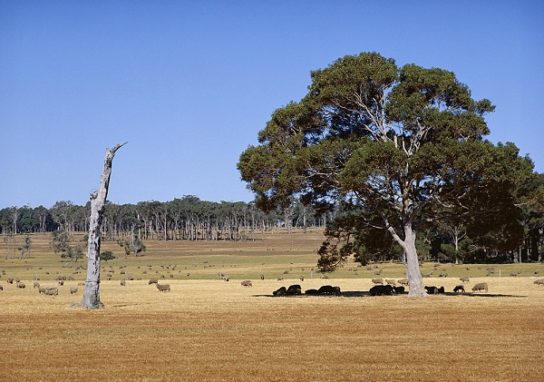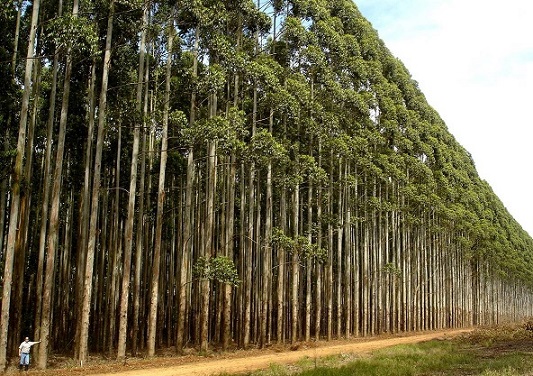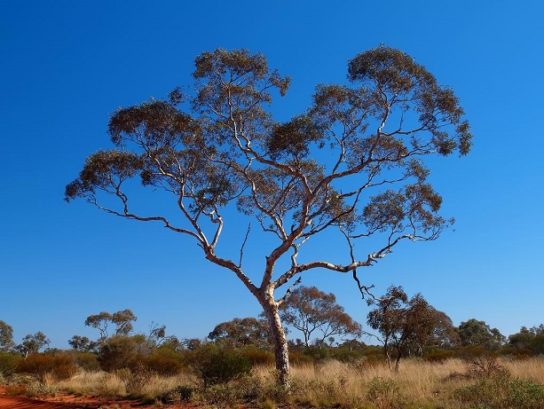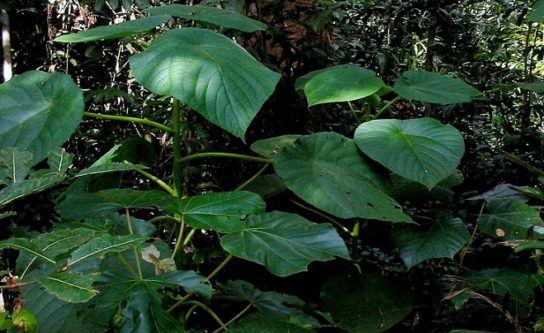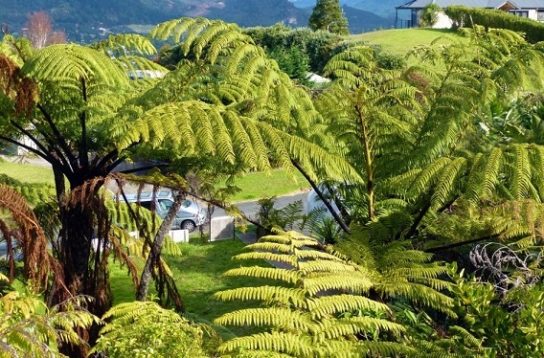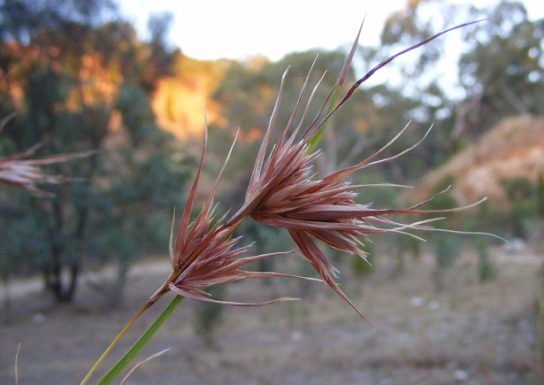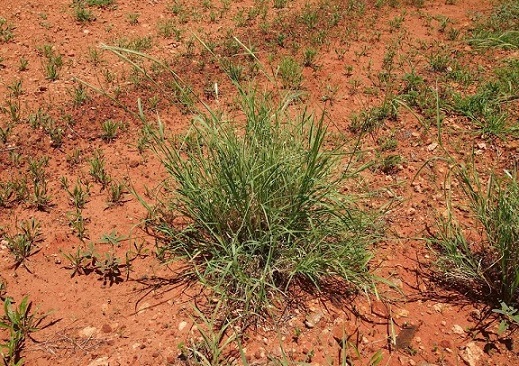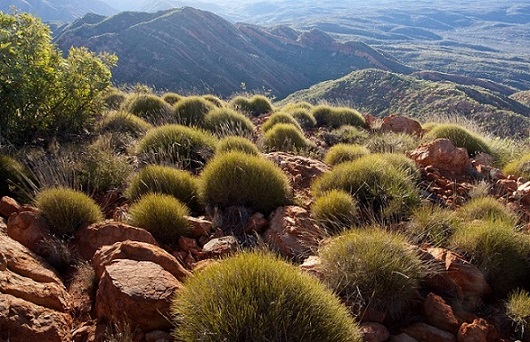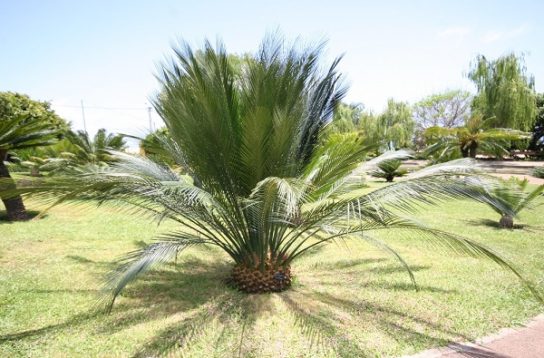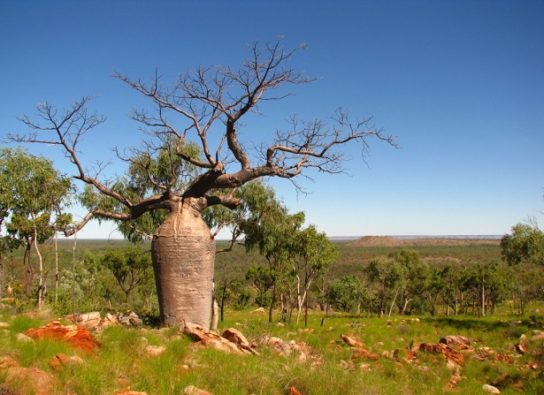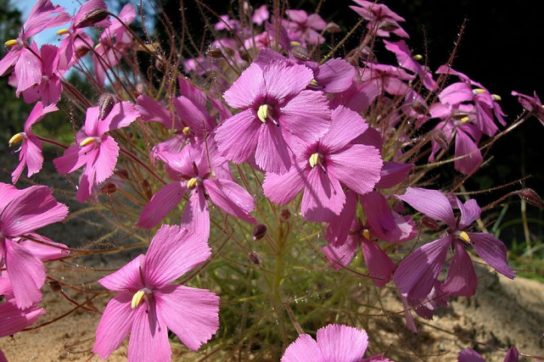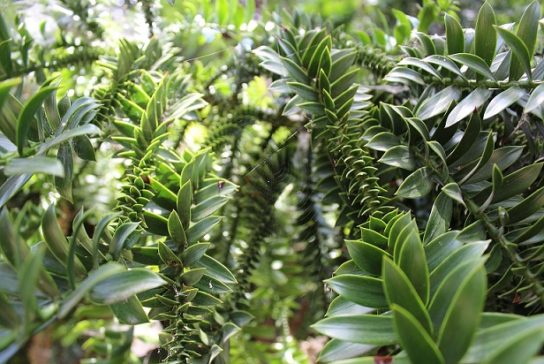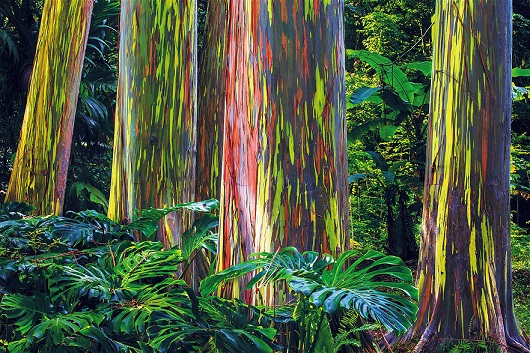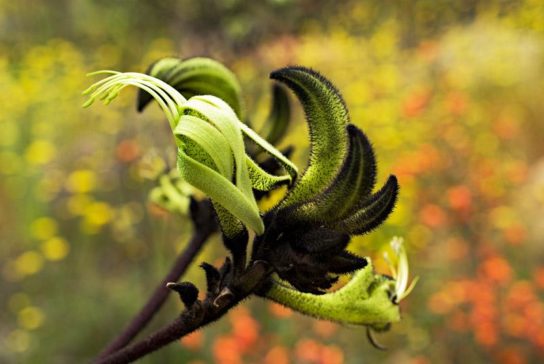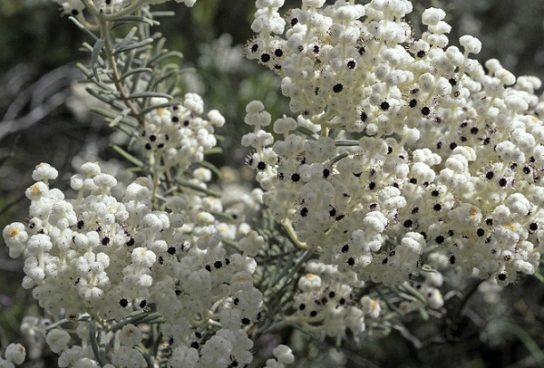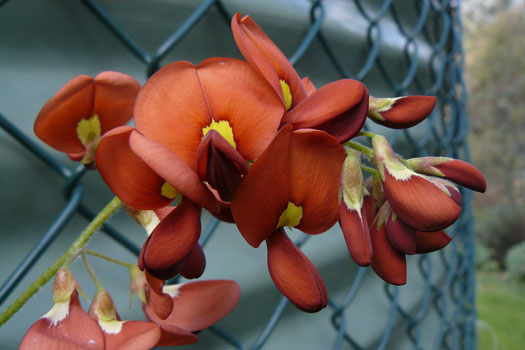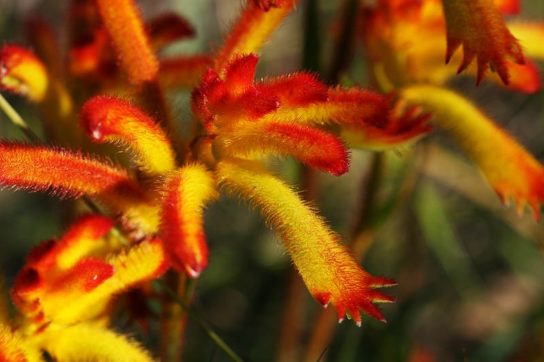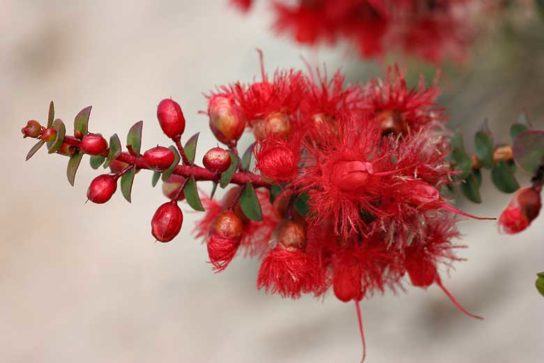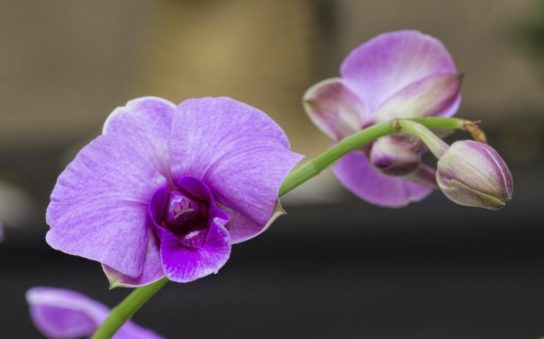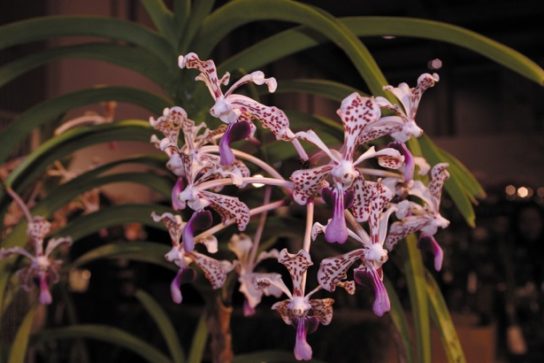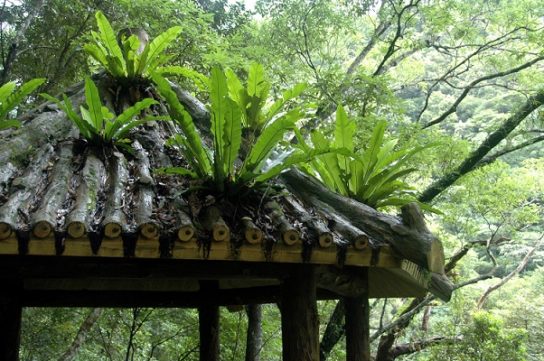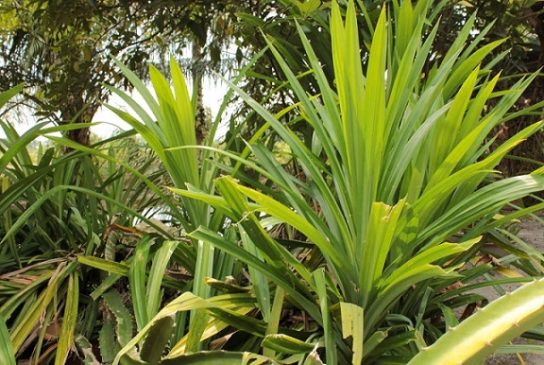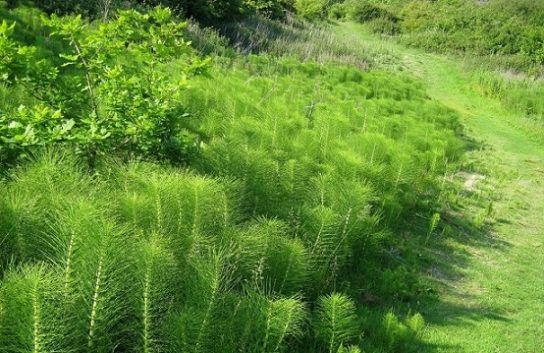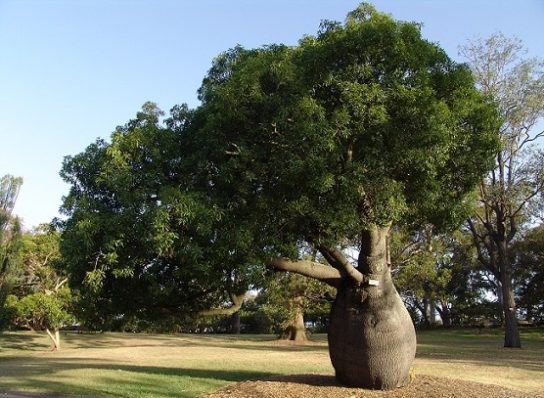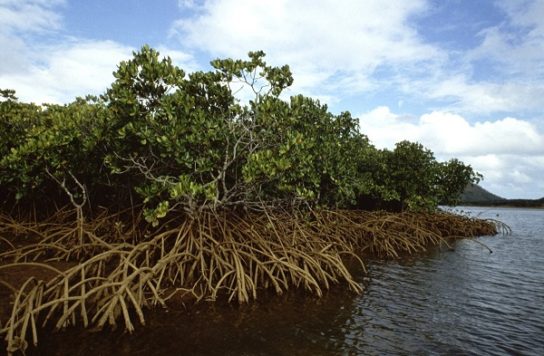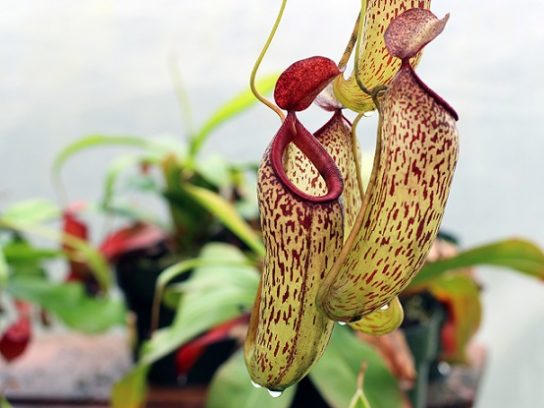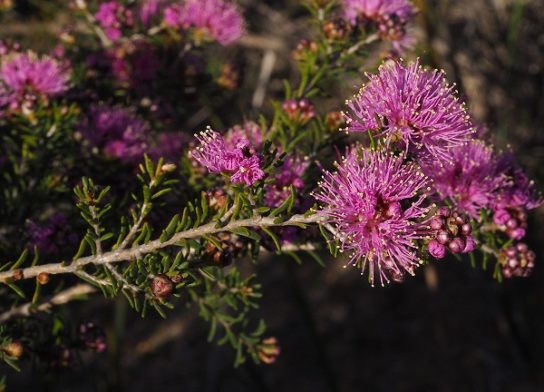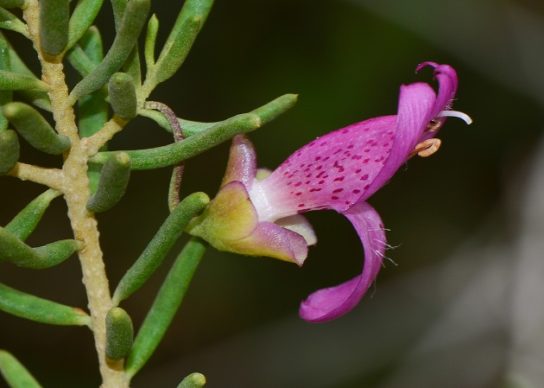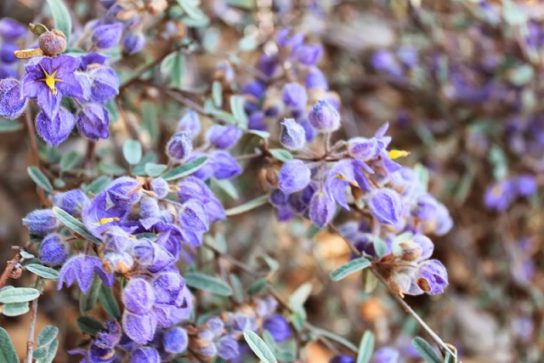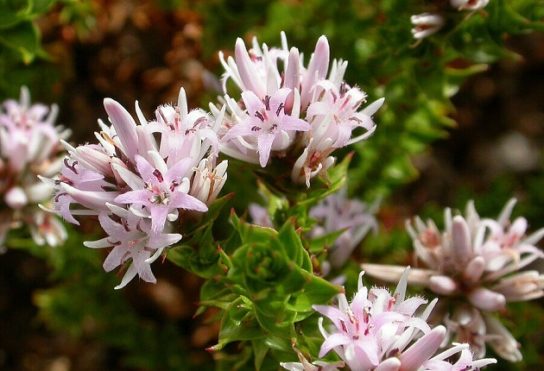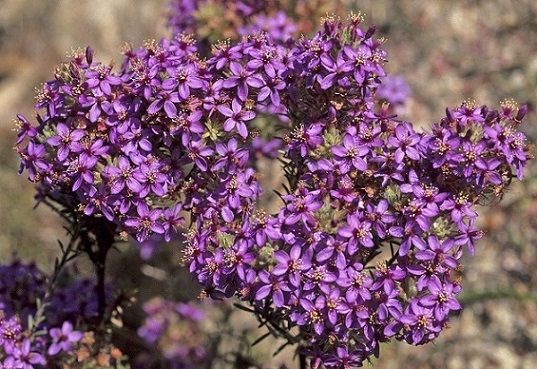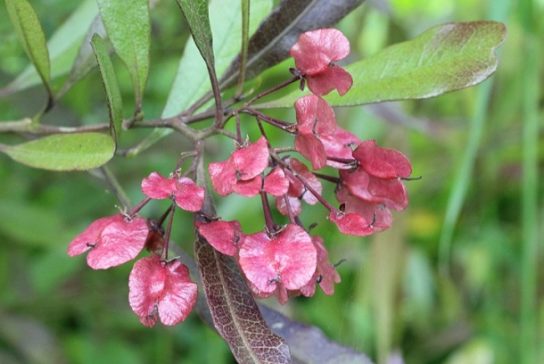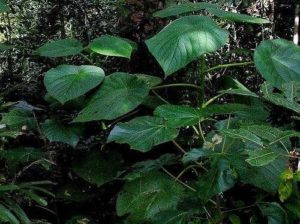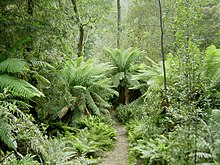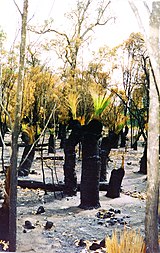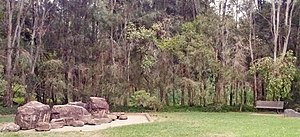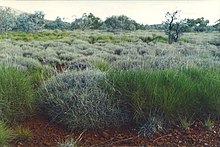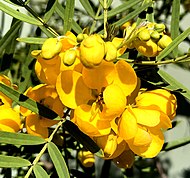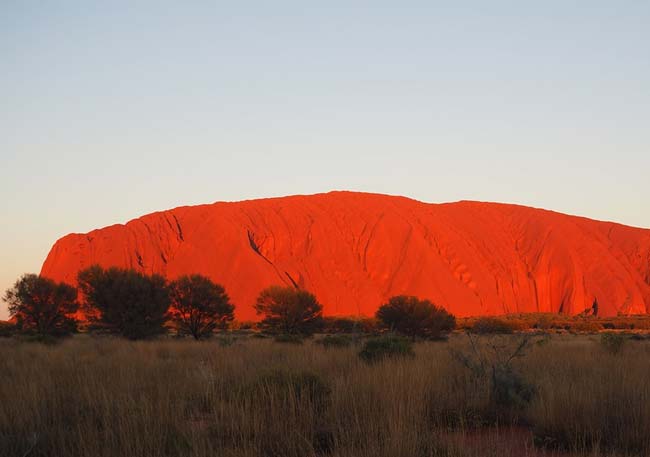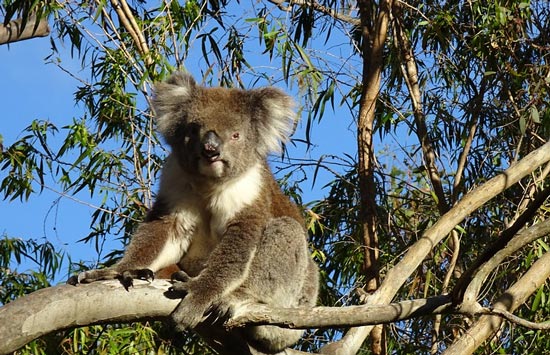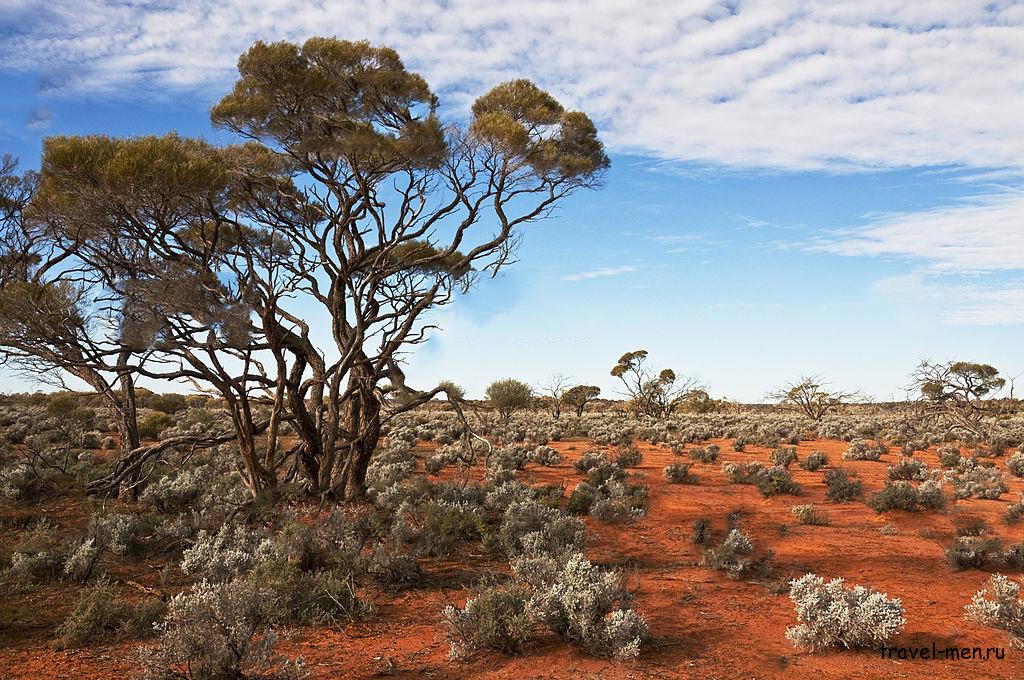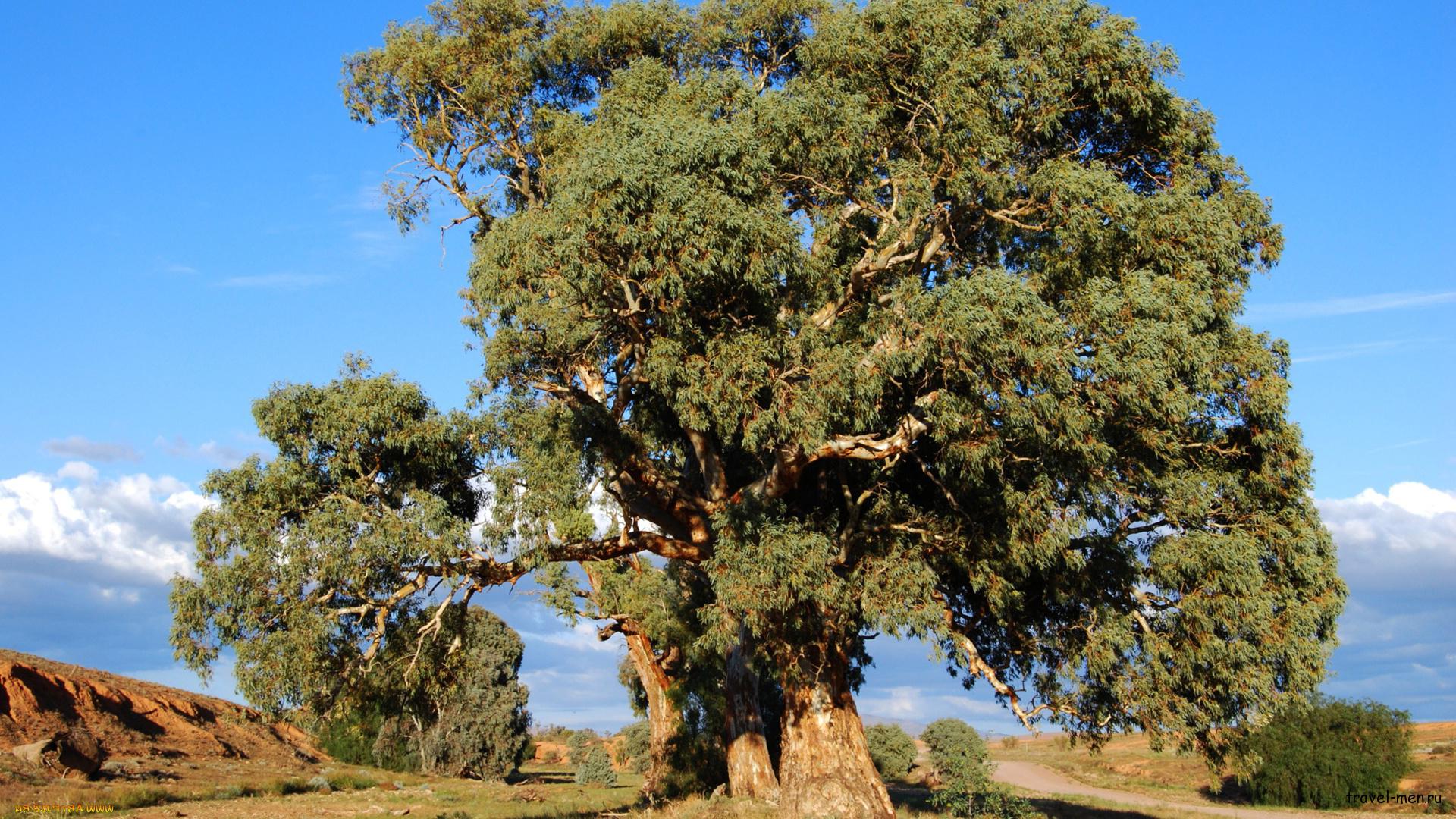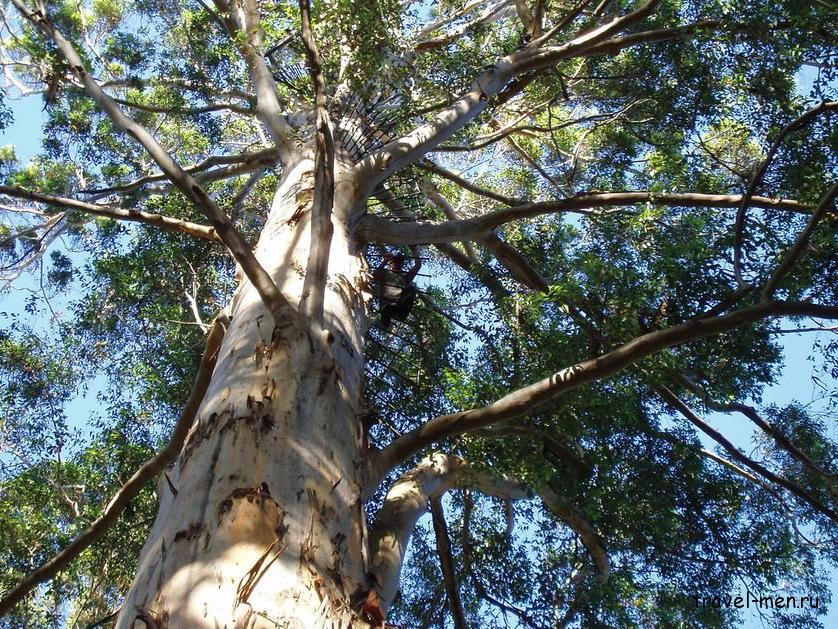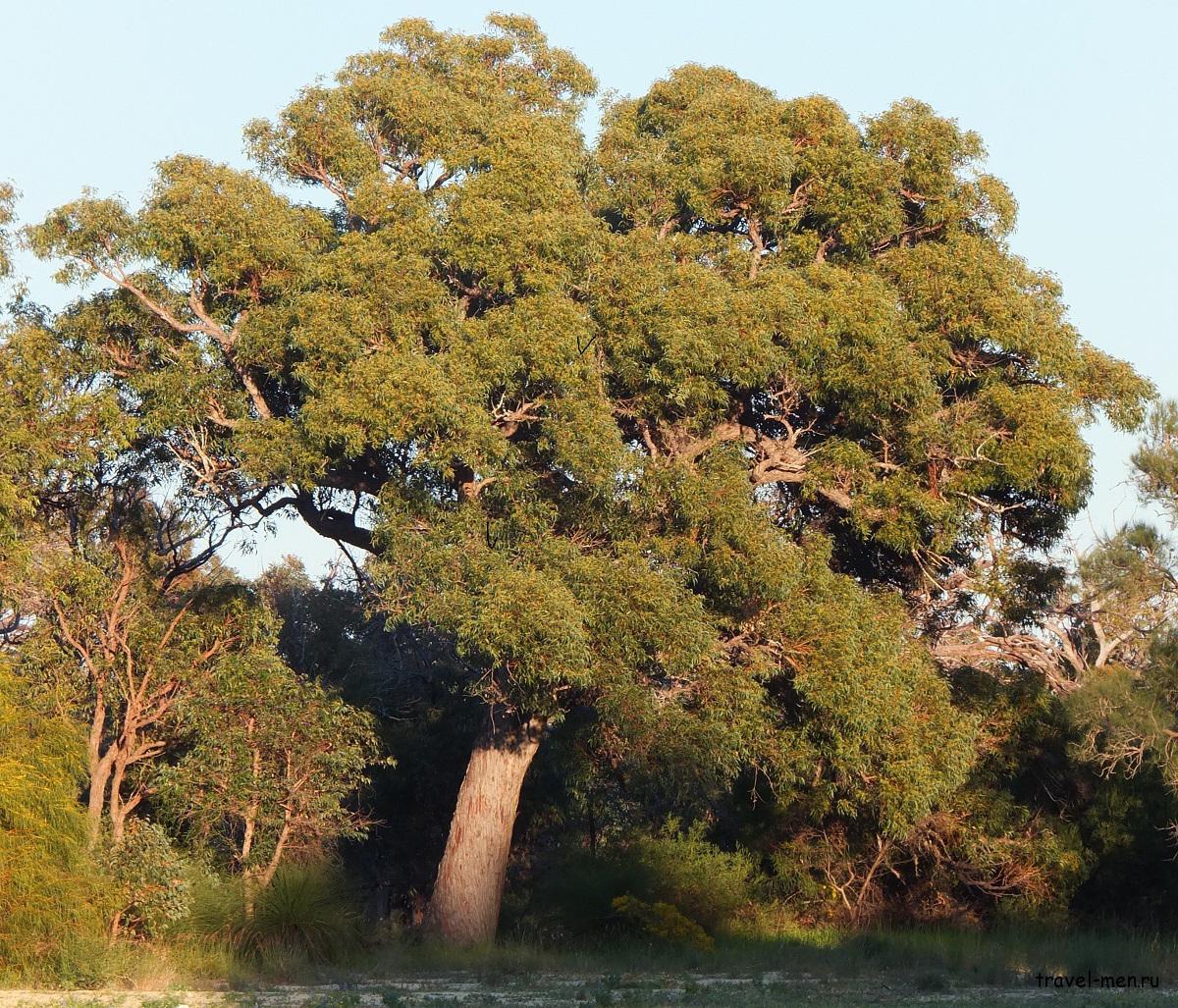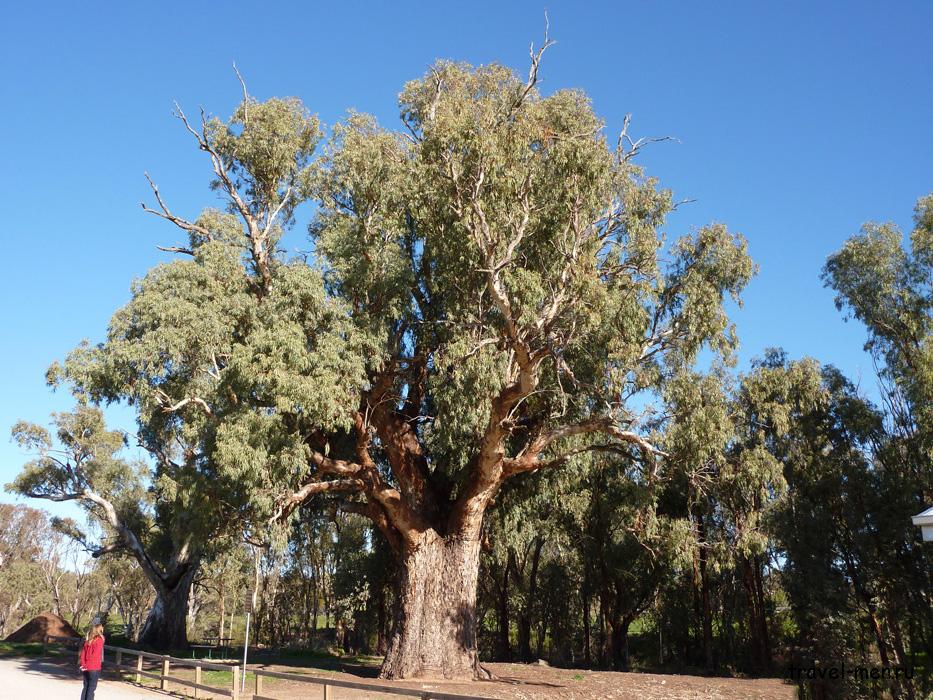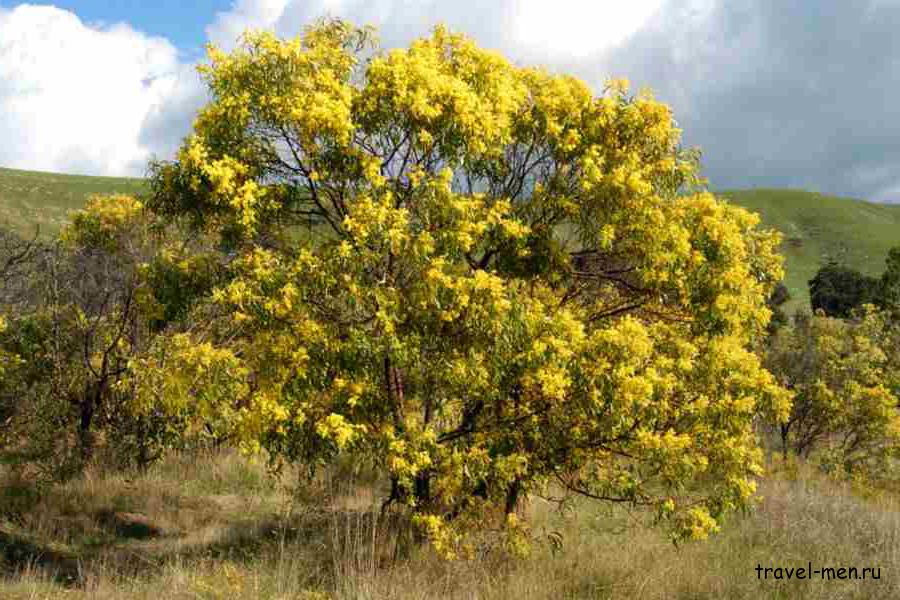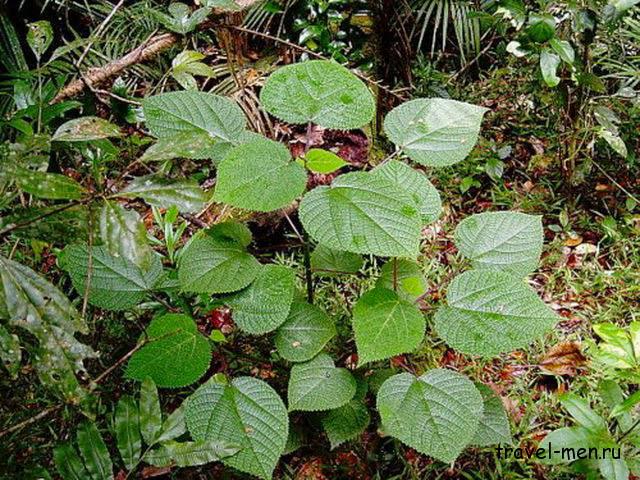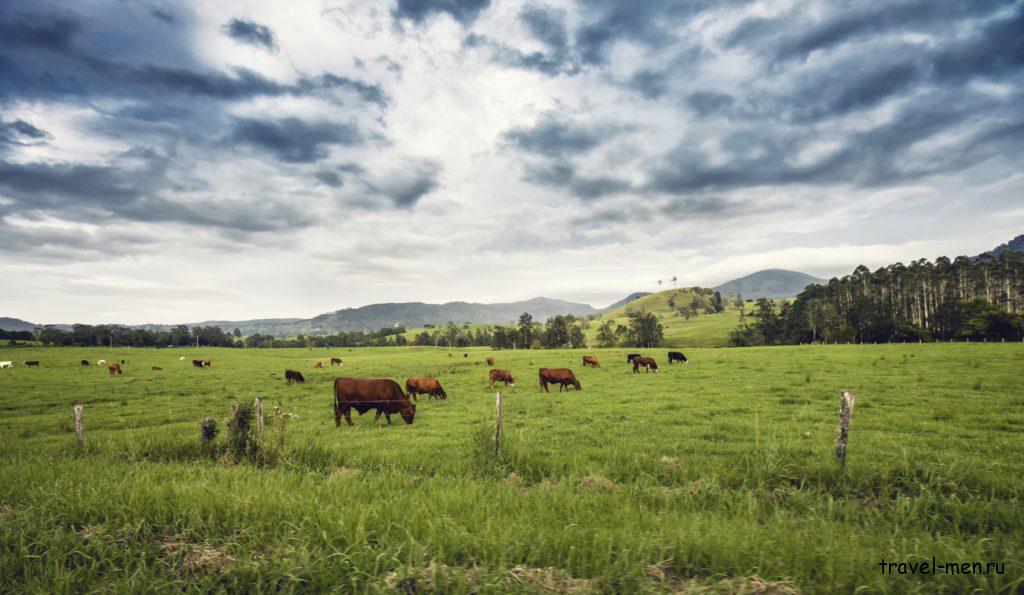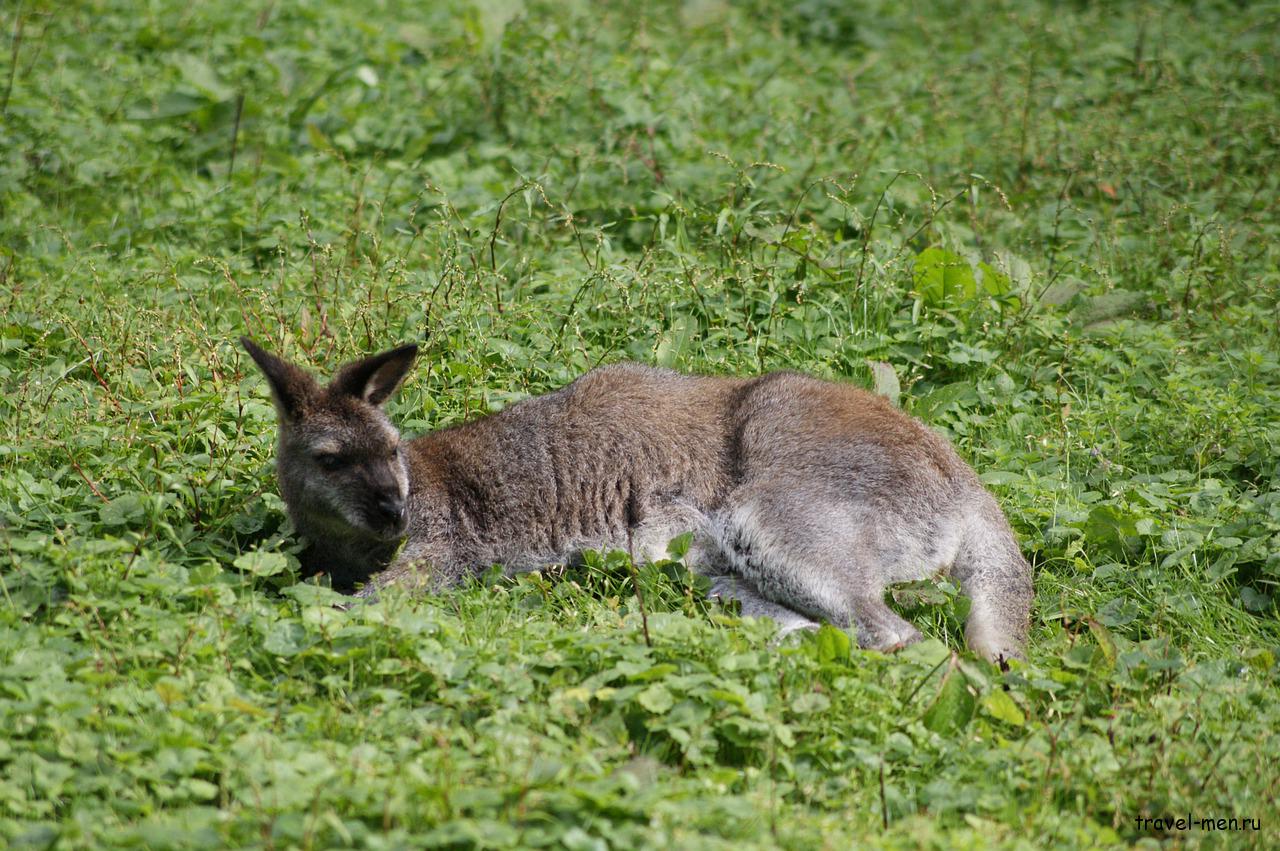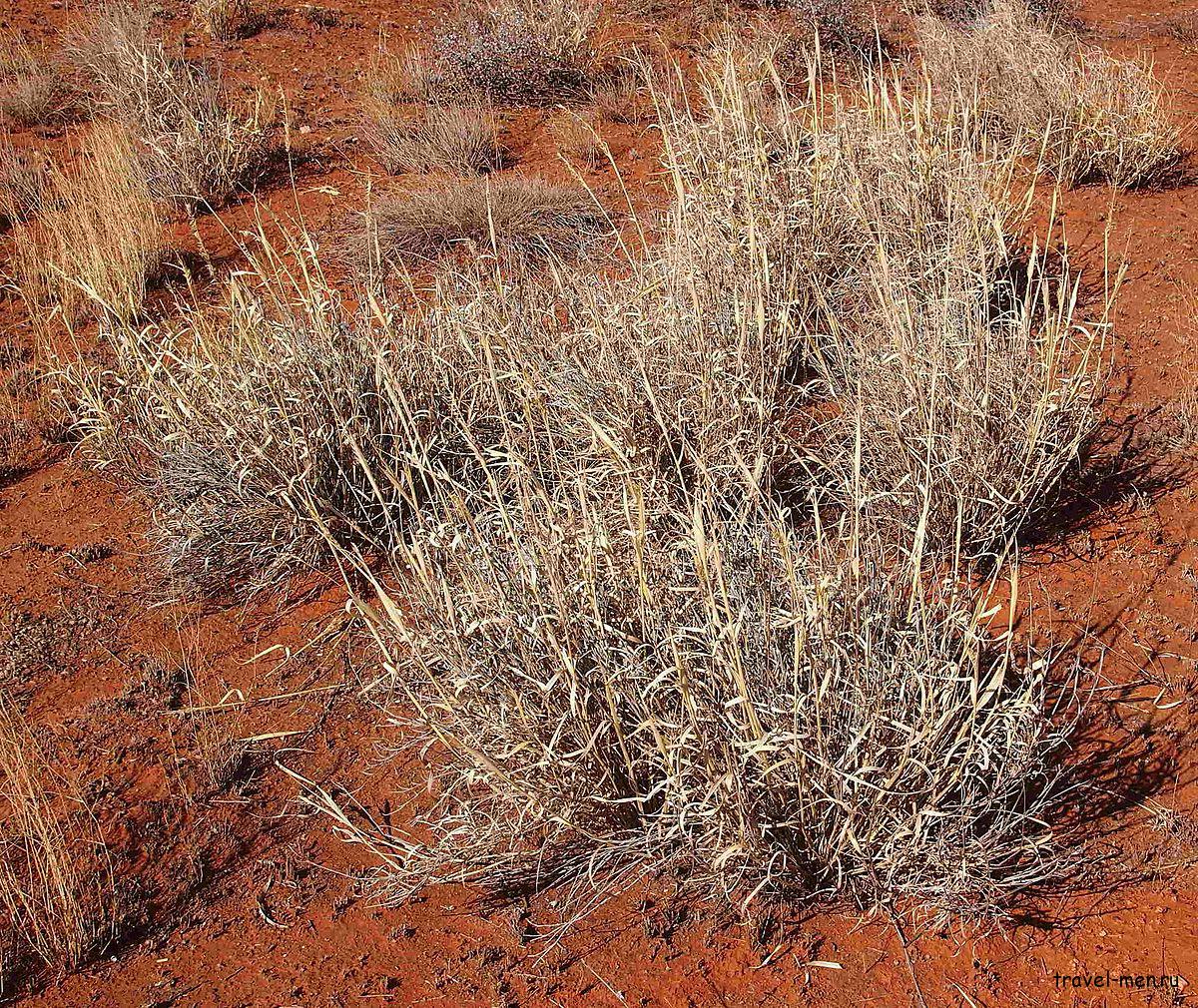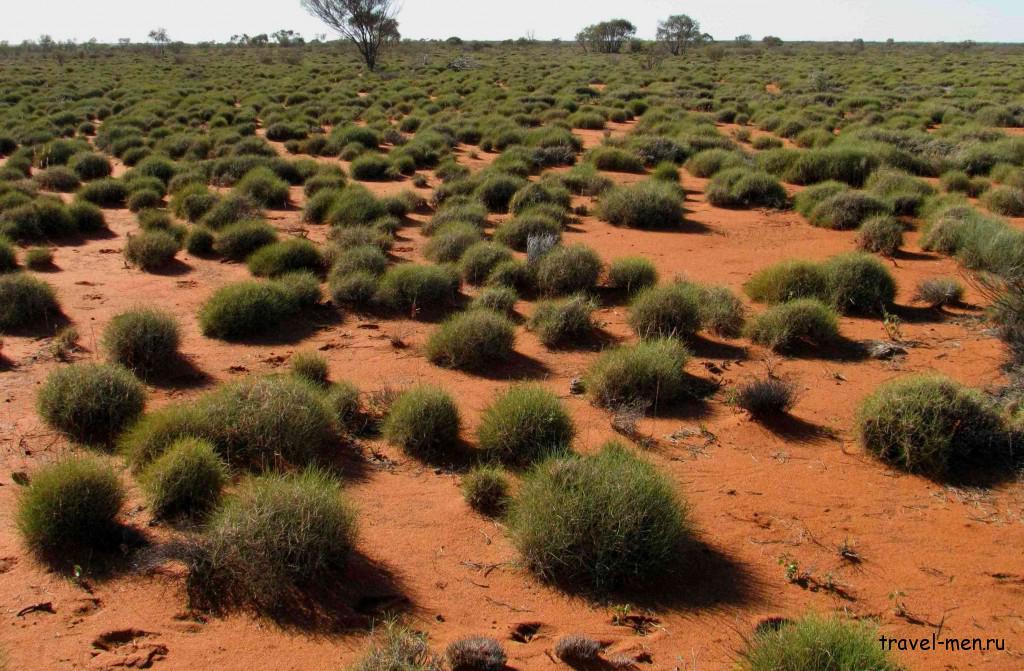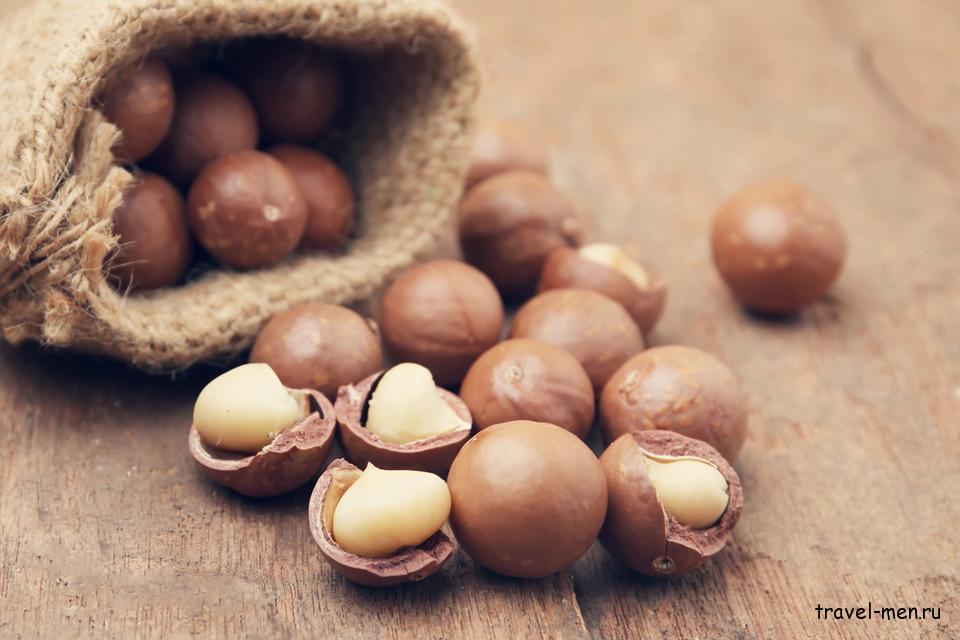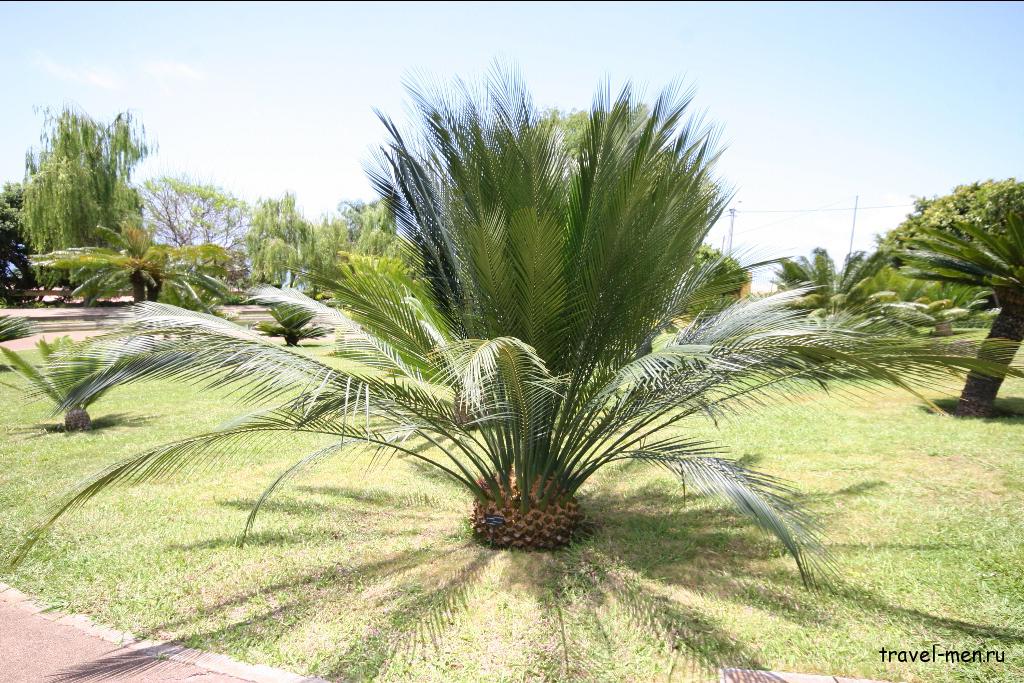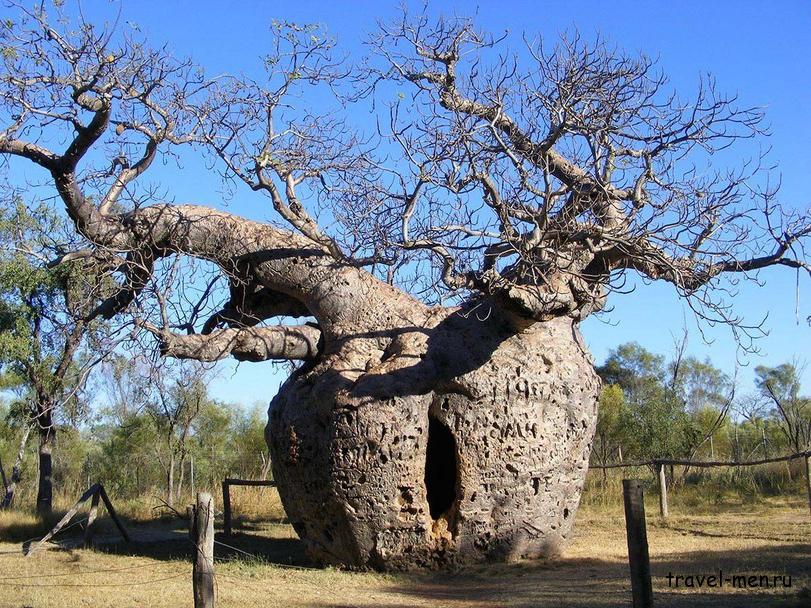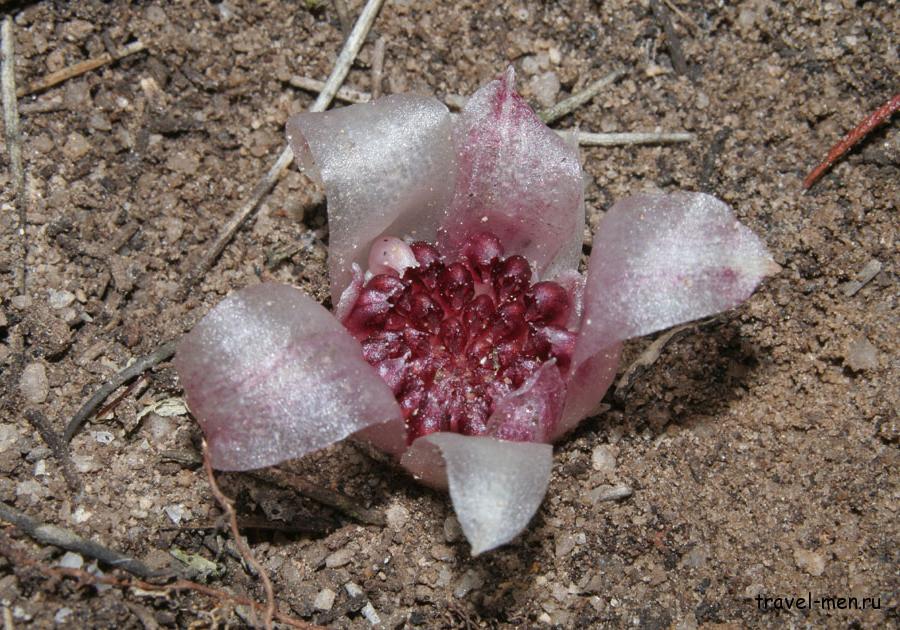Обновлено: 01 января 2023 в 13:37
187 549
Растительный мир Австралии начал формироваться несколько миллионов лет назад и на протяжении значительного времени эволюционировал в полной изоляции от растений с других континентов. Это обусловило его специфический вектор развития, что, в итоге, привело к большому количеству эндемичных видов. Эндемиков здесь настолько много, что материк вместе с островами называют «Австралийским флористическим царством».
Изучение австралийской флоры начал Джеймс Кук еще в 18 веке. Однако подробное описание местного мира растений было составлено только в начале 20 века. Рассмотрим наиболее заметные виды.
Карри
Джарра
Эвкалипт царственный
Эвкалипт камальдульский
Золотая акация
Жалящее дерево
Высокие папоротники
Трава кенгуру
Астребла
Спинифекс
Орехи макадамия
Макрозамия
Боаб
Библис гигантский
Ризантелла Гарднера
Другие растения Австралии
Араукария Бидвилла
Эвкалипт розовоцветковый
Макропидия черно-бурая
Лахностахис коровяколистный
Кеннедия нортклиффска
Анигозантос приземистый
Вертикордия крупная
Дендробиум биггибум
Ванда трехцветная
Банксия
Фикус
Пальма
Эпифит
Панданус
Хвощ
Бутылочное дерево
Мангры
Непентес
Гревиллея параллельная
Мелалеука
Эремофила Фрэзера
Керадрения подобная
Андерсония крупнолистная
Розовый астроцветный каллитрикс
Додонея
Изопогон лесорогий
Вывод
Пожалуй, самым экстравагантным австралийским растением является жалящее дерево. Его листья и ветви буквально пропитаны сильным ядом, вызывающим раздражение, воспаление и опухоль на коже. Действие продолжается до нескольких месяцев. Известен случай контакта человека с деревом, приведший к летальному исходу. От жалящих деревьев в Австралии регулярно гибнут домашние кошки и собаки. Интересно, что плодами этого дерева благополучно питаются некоторые сумчатые животные.
Еще одно необычное дерево – баобаб. Он обладает очень толстым стволом (около восьми метров в обхвате) и способен прожить более тысячи лет. Точный возраст баобаба определить очень сложно, так как он не имеет обычных для большинства деревьев годичных колец на срезе ствола.
Также австралийский континент богат различными интересными травами. Например, здесь широко представлены различные виды росянки – цветка-хищника, питающегося попавшимися в соцветие насекомыми. Она произрастает по всей территории континента и насчитывает около 300 видов. В отличие от аналогичных растений на других материках, австралийская росянка имеет яркие соцветия, розового, голубого или желтого цвета.
Содержание
- Влияние климата на растения
- Эвкалипты
- Карри
- Джарра
- Эвкалипт царственный
- Эвкалипт камальдульский
- Акации
- Золотая акация
- Дождевые леса
- Жалящее дерево
- Склерофильный лес
- Луговые угодья
- Трава кенгуру
- Астребла
- Спинифекс
- Другие деревья и растения
- Орехи макадамия
- Макрозамия
- Боаб
- Вымершие и исчезающие растения
- Использование аборигенных растений
Австралия отделилась от суперконтинента Пангея более 50 миллионов лет назад, и виды растений, существовавших в то время, продолжали адаптироваться к условиям окружающей среды на изолированном участке суши.
Многие виды растений Австралии не встречаются нигде на Земле, кроме тех случаев, когда они были введены человеком. Такие виды известны как эндемичные. Это своеобразие является результатом длительной изоляции австралийского континента от других материков.
В австралийской растительности преобладают два типа растений – эвкалипт и акация. Известно 569 известных видов эвкалиптов и 772 вида акации. Тем не менее на континенте существует множество и других разновидностей флоры.
Читайте также:
- Флора Азии;
- Флора Африки;
- Флора Антарктиды;
- Флора Европы;
- Флора Америки.
- Флора Южной Америки.
Влияние климата на растения
Климат является основным фактором, влияющим на растительный мир Австралии. Самой поразительной особенностью австралийской природы в целом является ее сухость. Бедные питательными веществами почвы влияют на характер флоры континента, особенно в засушливых районах.
Половина территории материка получает менее 300 миллиметров осадков в год; небольшие части Австралии получают годовое количество осадков около 800 миллиметров. Поэтому леса покрывают лишь небольшой процент от общей площади суши.
Между уровнем осадков и растительностью существует тесная взаимосвязь. Небольшие районы тропических дождевых лесов находятся в горных районах северо-востока, в штате Квинсленд. В прохладных горах Нового Южного Уэльса, Виктории и Тасмании процветают обширные умеренные дождевые леса.
Однако более обширным, чем тропический лес, является склерофильный лес, который растет в южной части Восточного нагорья в Новом Южном Уэльсе и Виктории, Тасмании, и на юго-западе Западной Австралии.
Огромный открытый лес с деревьями разной высоты и открытым пологом, простирается по всей северной Австралии, восточной половине Квинсленда, внутренним равнинам Нового Южного Уэльса, и к северу от склерофильного леса Западной Австралии.
За пределами этого региона климат засушливый и преобладают кустарники с травянистыми растениями. Тропический север Квинсленда, Северной Территории и меньшей части Западной Австралии имеет обширные площади пастбищ.
Большая часть Западной и Южной Австралии, а также внутренние территории Нового Южного Уэльса и Квинсленда, покрыты кустарниками, где травы и небольшие деревья растут редко. В центре континента пустыня, которая имеет небольшую растительность, за исключением водотоков.
Эвкалипты
Более 500 видов эвкалиптов Австралии варьируются от тропических видов на севере до альпийских видов в южных горах. Количество осадков, температура и тип почвы определяют, какие именно эвкалипты будут найдены в определенной местности. Деревья эвкалипта доминируют в австралийских лесах на востоке и юге, в то время как более мелкие виды эвкалипта – кустарники – растут в сухих лесных или кустарниковых районах.
Проще упомянуть части Австралии, где эвкалипты не растут: ледяные вершины Австралийских Альп, внутренние пустыни, равнина Налларбор, тропические и умеренные дождевые леса Восточного нагорья.
Многие из местных растений Австралии, наряду с эвкалиптами, демонстрируют типичные адаптации к засушливому климату, такие как глубокие корневища, которые могут доходить до уровня грунтовых вод. Другая общая черта – маленькие блестящие листья, которые уменьшают испарение.
Листья эвкалипта жесткие или кожистые описаны как склерофиллы. Склерофильные леса эвкалиптов покрывают более влажные районы Австралии, Восточного нагорья или Великого разделительного хребта, а также юго-запада Западной Австралии.
Древесина лиственных пород из этих лесов, как правило, не подходит для строительства, поэтому площади очищаются и деревья перерабатываются в древесную щепу, которая экспортируются для производства газетной бумаги.
Юго-западный край Западной Австралии имеет великолепные леса с двумя уникальными видами карри и джарра.
Карри
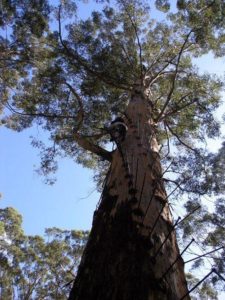
Карри – одно из самых высоких деревьев в мире, вырастает до 90 метров в высоту. Это ценное дерево лиственных пород широко используется в строительстве. Длинные, прямые стволы покрыты гладкой корой, которая имеет розовые и серые оттенки.
Джарра
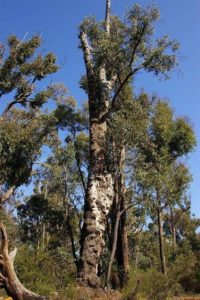
Джарра вырастает до 40 метров в высоту и представляет собой тяжелую, прочную древесину. В девятнадцатом веке дерево использовали для дорожного строительства, однако сейчас темно-красная древесина высоко ценится при изготовлении мебели, напольных покрытий и обшивочных материалов.
Эвкалипт царственный
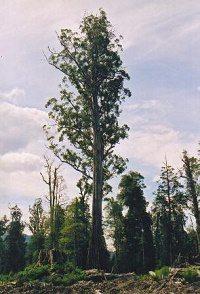
В девятнадцатом веке Австралия могла также претендовать на то, чтобы быть домом для самых высоких деревьев в мире – эвкалиптов царственных. Самое высокое дерево, которое, как утверждают наблюдатели, было высотой 132 метра, а верхняя его часть была срублена в 1872 году. Самое высокое дерево с точным измерением было высотой 114 метров, однако после пожара в 2003 году, дерево погибло.
Эвкалипт камальдульский
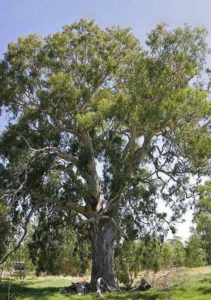
Наиболее широко распространенный из всех австралийских эвкалиптов – красивый эвкалипт камальдульский. Эти деревья растут вдоль берегов рек и водотоков по всей стране, особенно во внутренних районах; их разветвляющиеся ветви обеспечивают широкие тени и места обитания для многих животных Австралии.
В более засушливых внутренних районах и на некоторых горных участках насчитывается более ста видов эвкалиптов небольших размеров, которые известны под названием мали.
Австралийские эвкалипты были введены во многие страны, включая Италию, Египет, Эфиопию, Индию, Китай и Бразилию, и они распространены в Калифорнии, где растут уже в течение 150 лет.
Акации
Ранние европейские каторжники и поселенцы использовали гибкие веточки акации для плетения и создавали прочный фундамент для соломенной крыши или стен. Затем стены покрывались внутри и снаружи грязью. Этот тип строительства был распространен по всей Австралии.
Золотая акация
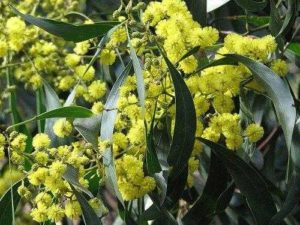
У акации есть масса ярких цветов, обычно ярко-желтых. Один вид – золотая акация – является национальным цветком Австралии. Она вырастает до 12 м в высоту и имеет филлоды (сплющенные листовые стебли) вместо настоящих листьев.
Дождевые леса
Хотя дождевая лесная растительность охватывает лишь небольшую часть Австралии, она исключительно разнообразна и представляет большой научный интерес. Ни один из двух общих типов тропических лесов, найденных в Австралии, не содержит эвкалиптов. Дождевые леса расположены вдоль Большого Водораздельного хребта.
В небольших районах Квинсленда находится тропический дождевой лес, который по видовому разнообразию флоры аналогичен с индонезийским и малазийским дождевыми лесами. Тропический лес является естественной средой обитания для тысячи видов деревьев, включая: лианы, крапивные деревья и жалящие деревья, чьи прикосновения могут сильно обжечь неосторожного исследователя.
Жалящее дерево
Это самое ядовитое растение из рода Dendrocnide. Его листья, а также ветви вызывают сильный ожог при прикосновении к ним. Тем не менее листьями и плодами жалящего дерева питаются некоторые сумчатые, птицы и насекомые.
К северу от Нового Южного Уэльса растет субтропический дождевой лес. В прохладном, влажном штатов Виктория и Тасмания есть обширные области умеренных тропических лесов, где доминируют лишь немногие деревья, включая нотофагусы, а также высокие папоротники.
Склерофильный лес
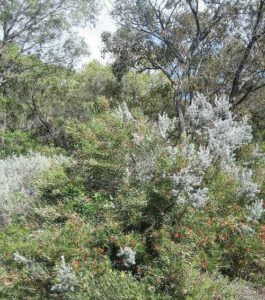
Это типичные австралийские кустарники, растущие на побережье Нового Южного Уэльса, Виктории и Тасмании. Яркое австралийское солнце проходит через редкие кроны и узкие листья эвкалиптов. По мере того, как климат становится все более сухим, дальше от берега, открытый лес медленно переходит в кустарниковую лесистую растительность.
Луговые угодья
Двигаясь дальше вглубь суши, в еще более сухие регионы, лесные массивы переходят в пастбища, где выращивают КРС для получения мяса и овец – для шерсти.
Трава кенгуру
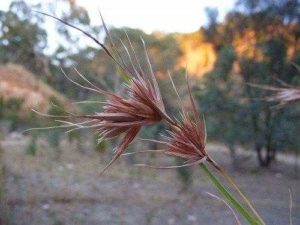
Трава кенгуру когда-то была распространена на территории Нового Южного Уэльса, однако большая часть была уничтожена для выращивания сельскохозяйственных культур, особенно пшеницы.
Астребла
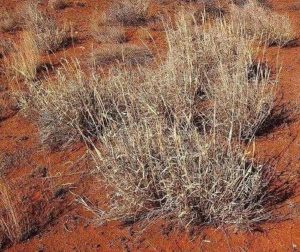
Астребла, также известная как трава митчелла – еще одна трава австралийского континента. Она является доминирующей травой на большей части материка, в Квинсленде и в Северной Территории. Крупный рогатый скот и овцы питаются этой травой.
Спинифекс
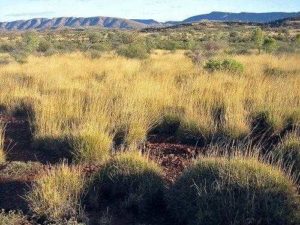
В австралийских пастбищах преобладает спинифекс – это колючая трава, которая растет в засушливых районах. Даже крупный рогатый скот не может питаться травой спинифекс, поэтому эта экосистема менее подвержена угрозе, чем большинство других лугов.
Другие деревья и растения
Орехи макадамия
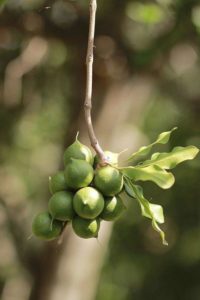
Многие люди думают, что орехи макадамия являются уроженцами штата Гавайи, которые производят 90% урожая в мире, но на самом деле это дерево родом из Австралии. Деревья были ввезены на Гавайи в 1882 году.
Макрозамия
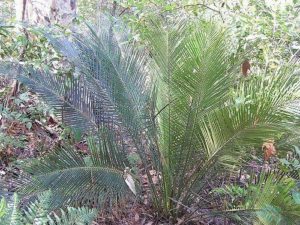
Макрозамия – растение, напоминающее папоротник. Род включает в себя более 40 видов, которые являются эндемиками Австралии. Большая часть видов распространена в восточной части страны, на юго-востоке Квинсленда и в Новом Южном Уэльсе.
Боаб
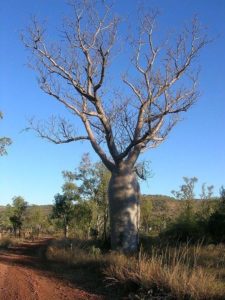
На северо-западе Австралии можно найти дерево боаб, известное как австралийский баобаб или бутылочное дерево. Как и в случае с другими баобабами, это дерево легко распознается по стволу большого диаметра, придавая дереву форму бутылки. Эндемичный для Австралии боаб встречается в округе Кимберли в Западной Австралии и на востоке Северной Территории. Его высота колеблется в пределах от 5 до 15 м, а диаметр ствола не превышает 5 м.
Вымершие и исчезающие растения
Человеческая деятельность в Австралии привела к исчезновению более восьмидесяти видов растений, а список находящихся под угрозой растений содержит более двухсот видов. Многие неродные виды были введены в Австралию европейцами.
Некоторые из них стали вредителями, как ежевика в штате Виктория, лантана в северной части Квинсленда, а также водяной гиацинт, найденный на всем континенте. В Австралии насчитывается 462 национальных парка, а также другие заповедники, в которых защищена местная флора.
Использование аборигенных растений
Австралийские аборигены использовали растения в качестве источников пищи и в медицинских целях. Пищевые растения включали орехи, семена, ягоды, корни и клубни. Аборигены питались нектаром цветущих растений, стеблями и корнями камышей.

Гугломаг
Спрашивай! Не стесняйся!
Задать вопрос
Не все нашли? Используйте поиск по сайту
«Australian plants» redirects here. For the magazine, see Australian Plants.
The flora of Australia comprises a vast assemblage of plant species estimated to over 30,000 vascular and 14,000 non-vascular plants, 250,000 species of fungi and over 3,000 lichens. The flora has strong affinities with the flora of Gondwana, and below the family level has a highly endemic angiosperm flora whose diversity was shaped by the effects of continental drift and climate change since the Cretaceous. Prominent features of the Australian flora are adaptations to aridity and fire which include scleromorphy and serotiny. These adaptations are common in species from the large and well-known families Proteaceae (Banksia), Myrtaceae (Eucalyptus — gum trees), and Fabaceae (Acacia — wattle).
The arrival of humans around 50,000 years ago[2][3] and the settlement by Europeans from 1788, has had a significant impact on the flora. The use of fire-stick farming by Aboriginal people led to significant changes in the distribution of plant species over time, and the large-scale modification or destruction of vegetation for agriculture and urban development since 1788 has altered the composition of most terrestrial ecosystems, leading to the extinction of 61 plant species by 2006, and endangering over 1000 more.
Origins and history[edit]
The Tasmanian rainforest is considered a Gondwanan relic.
Australia was part of the southern supercontinent Gondwana, which also included South America, Africa, India and Antarctica. Most of the modern Australian flora had their origin in Gondwana during the Cretaceous when Australia was covered in subtropical rainforest. Australian ferns and gymnosperms bear a strong resemblance to their Gondwanan ancestors,[4] and prominent members of the early Gondwanan angiosperm flora such as the Nothofagus, Myrtaceae and Proteaceae were also present in Australia.[5]
Gondwana began to break up 140 million years ago (MYA); 50 MYA during the Eocene Australia separated from Antarctica, and was relatively isolated until the collision of the Indo-Australian Plate with Asia in the Miocene era 5.3 MYA. As Australia drifted, local and global climatic change had a significant and lasting effect: a circumpolar oceanic current developed, atmospheric circulation increased as Australia moved away from Antarctica, precipitation fell, there was a slow warming of the continent and arid conditions started to develop.[6] These conditions of geographic isolation and aridity led to the development of a more complex flora. From 25 to 10 MYA pollen records suggest the rapid radiation of species like Eucalyptus, Casuarina, Allocasuarina, Banksia and the pea-flowered legumes, and the development of open forest; grasslands started to develop from the Eocene. Collision with the Eurasian Plate also led to additional South-east Asian and cosmopolitan elements entering the flora like the Lepidium and Chenopodioideae.[7]
The development of aridity and the old and nutrient poor soils of the continent led to some unique adaptations in the Australian flora and evolutionary radiation of genera – like Acacia and Eucalyptus – that adapted to those conditions. Hard leaves with a thick outer layer, a condition known as scleromorphy, and C4 and CAM carbon fixation which reduce water loss during photosynthesis are two common adaptations in Australian arid-adapted dicot and monocot species respectively.
Rising aridity also increased the frequency of fires in Australia. Fire is thought to have played a role in the development and distribution of fire-adapted species from the Late Pleistocene. An increase in charcoal in sediment around 38,000 years ago coincides with dates for the inhabitation of Australia by the Indigenous Australians and suggests that man-made fires, from practices like fire-stick farming, have played an important role in the establishment and maintenance of sclerophyll forest, especially on the east coast of Australia.[8] Adaptations to fire include lignotubers and epicormic buds in Eucalyptus and Banksia species that allow fast regeneration following fire. Some genera also exhibit serotiny, the release of seed only in response to heat and/or smoke. Xanthorrhoea grass trees and some species of orchids only flower after fire.[9]
Biogeography[edit]
In biogeography and zoogeography, Australia alone is sometimes considered a realm (Australian realm), while some authors unite the area with other regions to form the Australasian realm.
In phytogeography, the area is considered a floristic kingdom (Australian kingdom), with the following endemic families, according to Takhtajan: Platyzomataceae (now included in Pteridaceae), Austrobaileyaceae, Idiospermaceae, Gyrostemonaceae, Baueraceae, Davidsoniaceae, Cephalotaceae, Eremosynaceae, Stylobasiaceae, Emblingiaceae, Akaniaceae, Tremandraceae, Tetracarpaeaceae, Brunoniaceae, Blandfordiaceae, Doryanthaceae, Dasypogonaceae and Xanthorrhoeaceae. It is also the center of origin of Eupomatiaceae, Pittosporaceae, Epacridaceae, Stackhousiaceae, Myoporaceae and Goodeniaceae. Other families with high occurrences are Poaceae, Fabaceae, Asteraceae, Orchidaceae, Euphorbiaceae, Cyperaceae, Rutaceae, Myrtaceae (specially Leptospermoideae) and Proteaceae.[10][11]
Vegetation types[edit]
Major vegetation groups in Australia from the 2009 Atlas of Australian Resources
Australia’s terrestrial flora can be collected into characteristic vegetation groups. The most important determinant is rainfall, followed by temperature which affects water availability.[12] Several schemes of varying complexity have been created. As of 2022, the NVIS (National Vegetation Information System) divides Australia’s terrestrial flora into 33 Major Vegetation Groups,[13] and 85 Major Vegetation Subgroups.[14]
According to the scheme the most common vegetation types are those that are adapted to arid conditions where the area has not been significantly reduced by human activities such as land clearing for agriculture. The dominant vegetation type in Australia is the hummock grasslands that occur extensively in arid Western Australia, South Australia and the Northern Territory. It accounts for 23% of the native vegetation, the predominant species of which are from the genus Triodia. Zygochloa also occurs in inland sandy areas like the Simpson Desert.
A further 39% of native vegetation is covered by a combination of:
- Eucalypt woodlands found at the transition between hummock grasslands and higher rainfall areas where conditions still limit tree growth; the woodland may have a grass or shrubby understory. The largest area is in Queensland.
- Acacia forests and woodlands that occur in semi-arid areas where tree growth is stunted.[15] The dominant Acacia species varies with the location, and may include lancewood, bendee, mulga, gidgee and brigalow. The largest area is in Western Australia.[16]
- Acacia shrublands in semi arid and arid regions. The most common are mulga shrublands; the largest area is in Western Australia.
- Tussock grasslands that occur in semi-arid and some temperate[clarification needed] parts of Australia; they host a large variety of grasses from more than 10 genera. The largest area is in Queensland.
- Chenopod/samphire shrubs and forblands that are widespread in the near-estuarine, arid and semi-arid areas. Species in chenopod communities are drought and salt tolerant and include the genera Sclerolaena, Atriplex, Maireana, Chenopodium and Rhagodia while samphire representatives include Tecticornia, Salicornia, Sclerostegia and Sarcocornia. Both South and Western Australia have large areas with this vegetation type.
Other groups with restricted areas of less than 70,000 square kilometres include tropical or temperate rainforest and vine thickets, tall or open eucalypt forests, Callitris and Casuarina forests, and woodlands and heath.
Vascular plants[edit]
Australia has over 30,000 described species of vascular plants, these include the angiosperms, seed-bearing non-angiosperms (like the conifers and cycads), and the spore-bearing ferns and fern allies.[17] Of these about 11% are naturalised species; the remainder are native or endemic.[18] The vascular plant flora has been extensively catalogued, the work being published in the ongoing Flora of Australia series. A list of vascular plant families represented in Australia using the Cronquist system is also available.[19]
At the higher taxonomic levels the Australian flora is similar to that of the rest of the world; most vascular plant families are represented within the native flora, with the exception of the cacti, birch and a few others, while 9 families occur only in Australia.[20][21] Australia’s vascular flora is estimated to be 85% endemic;[22] this high level of vascular plant endemism is largely attributable to the radiation of some families like the Proteaceae, Myrtaceae, and Fabaceae.
Angiosperms[edit]
| Family | % of total flora1 | Notable genera |
|---|---|---|
| Fabaceae | 12.0 | Acacia, Pultenaea, Daviesia, Bossiaea |
| Myrtaceae | 9.3 | Callistemon, Eucalyptus, Melaleuca, Leptospermum |
| Asteraceae | 8.0 | Brachyscome, Olearia |
| Poaceae | 6.5 | Triodia |
| Proteaceae | 5.6 | Banksia, Hakea, Grevillea |
| Cyperaceae | 3.3 | Cyperus |
| Orchidaceae | 3.0 | Caladenia, Pterostylis |
| Ericaceae | 2.1 | Leucopogon, Epacris |
| Euphorbiaceae | 2.0 | Ricinocarpos |
| Rutaceae | 1.8 | Boronia, Correa, Citrus |
| 1 Based on total number of species
Data from Orchard modified to AGPII classifications.[17] |
The native Australian flora contains many monocotyledons. The family with the most species is the Poaceae which includes a huge variety of species, from the tropical bamboo Bambusa arnhemica to the ubiquitous spinifex that thrives in arid Australia from the genus Triodia. There are more than 800 described species of orchid in Australia.[23] About one quarter of these are epiphytes. The terrestrial orchids occur across most of Australia, the majority of species being deciduous – their aboveground parts die back during the dry season and they re-sprout from a tuber when it rains.
Other families with well-known representatives include the alpine Tasmanian button grass, which form tussock-like mounds from the Cyperaceae; the genus Patersonia of temperate iris-like forbs from the Iridaceae; and, the kangaroo paws from the family Haemodoraceae. The Xanthorrhoea grass trees, the screw palms of the Pandanaceae and palms are large monocots present in Australia. There are about 57 native palms; 79% of these only occur in Australia.[24]
The dicots are the most diverse group of angiosperms. Australia’s best known species come from three large and very diverse dicot families: the Fabaceae, the Myrtaceae and the Proteaceae. The Myrtaceae is represented by a variety of woody species; gum trees from the genera Eucalyptus, Corymbia and Angophora, Lillipillies (Syzygium), the water-loving Melaleuca and Bottlebrush and the shrubby Darwinia and Leptospermum, commonly known as teatrees, and Geraldton wax. Australia is also a centre of diversity for the Proteaceae, with woody, well-known genera such as Banksia, Dryandra, Grevillea, Hakea, the waratah and Australia’s only commercial native food crop, the macadamia. Australia also has representatives of all three legume subfamilies. Caesalpinioideae is notably represented by Cassia trees. The Faboideae or pea-flowered legumes are common and many are well known for their flowers, including the golden peas, Glycine species and the Sturt’s desert pea. The Mimosoideae is best known for the huge genus Acacia which includes Australia’s floral emblem the golden wattle.
Many plant families that occur in Australia are known for their floral displays that follow seasonal rains. The Asteraceae is well represented by its subfamily Gnaphalieae, which included the paper or everlasting daisies; this group has its greatest diversity in Australia. Other families with flowering shrubs include the Rutaceae, with the fragrant Boronia and Eriostemon, the Myoporaceae with the Eremophila, and members of the Ericaceae with Victoria’s Floral Emblem Epacris impressa.
Amongst the most ancient species of flowering hardwood trees are the Casuarinaceae, including beach, swamp and river oaks, and Fagaceae represented in Australia by three species of Nothofagus. Trees of the Rosales are notably represented by the Moraceae whose species include the Moreton Bay Fig and the Port Jackson Fig, and the Urticaceae whose members include several tree sized stinging nettles; Dendrocnide moroides is the most virulent. There are also numerous sandalwood species including the quandongs and native cherry, Exocarpus cupressiformis. The bottle tree of the Sterculiaceae is one of 30 tree species from the Brachychiton. There are about 75 native mistletoes that parasitise Australian tree species, including two terrestrial parasitic trees, one of which is the spectacular Western Australian Christmas tree.
Australia’s salt marshes and wetlands are covered by a large variety of salt and drought tolerant species from the Amaranthaceae which include the saltbushes (Atriplex) and bluebushes (Maireana and Chenopodium). Many of these plants have succulent leaves; other native succulents are from the genera Carpobrotus, Calandrinia and Portulaca. Succulent stems are present in many of the Euphorbiaceae in Australia, though the best known members are the non-succulent looking fragrant Wedding bushes of the genus Ricinocarpos. Carnivorous plants which favour damp habitats are represented by four families including the sundews, bladderworts, pitcher-plants from the Cephalotaceae, which are endemic to Western Australia, and the Nepenthaceae.
Aquatic monocots and dicots both occur in Australian waters. Australia has about 51,000 square kilometres of seagrass meadows and the most diverse group seagrass species in the world. There are 22 species found in temperate waters and 15 in tropical waters out of a known 70 species worldwide.[25] Aquatic dicots include the mangroves; in Australia there are 39 mangrove species that cover 11,500 square kilometres and comprise the third largest area of mangroves in the world.[26] Other native aquatic dicots here include water lilies and water milfoils.
Gymnosperms[edit]
Gymnosperms present in Australia include the cycads and conifers. There are 69 species of cycad from 4 genera and 3 families of eastern and northern Australia, with a few in south-western Western Australia and central Australia[clarification needed]. Native conifers are distributed across 3 taxonomic families (Cupressaceae, Podocarpaceae, Araucariaceae), 14 genera and 43 species, of which 39 are endemic. Most species are present in wetter mountainous areas consistent with their Gondwanan origins, including the genera Athrotaxis, Actinostrobus, Microcachrys, Microstrobos, Diselma and the Tasmanian Huon pine, sole member of the genus Lagarostrobos. Callitris is a notable exception; species from this genus are found mainly in drier open woodlands.[27] The most recently discovered species of conifer is the living fossil Wollemi pine, which was first described in 1994. Although many Australian conifers are referred to as ‘pines’, there are no members of the pine family (Pinaceae) native to Australia.
Ferns and fern allies[edit]
Spore bearing vascular plants include the ferns and fern allies. True ferns are found over most of the country and are most abundant in tropical and subtropical areas with high rainfall. Australia has a native flora of 30 families, 103 genera and 390 species of ferns, with another 10 species being naturalised. The «fern allies» are represented by 44 native species of whisk ferns, horsetails and lycophytes.[27] Ferns prefer a cool and damp environment since water is required for reproduction, the majority of Australian species are found in bushland[clarification needed] and rainforest, there are aquatic, epiphytic (Platycerium, Huperzia and Asplenium), and terrestrial species including large tree ferns from the genera Cyathea and Dicksonia.
Non-vascular plants[edit]
The algae are a large and diverse group of photosynthetic organisms. Many studies of algae include the cyanobacteria, in addition to micro and macro eukaryotic types that inhabit both fresh and saltwater. Currently, about 10,000 to 12,000 species of algae are known for Australia.[28] The algal flora of Australia is unevenly documented: northern Australia remains largely uncollected for seaweeds and marine phytoplankton, descriptions of freshwater algae are patchy, and the collection of terrestrial algae has been almost completely neglected.[29]
The bryophytes – mosses, liverworts and hornworts – are primitive, usually terrestrial, plants that inhabit the tropics, cool-temperate regions and montane areas; there are some specialised members that are adapted to semi-arid and arid Australia. There are slightly fewer that 1,000 recognised species of moss in Australia. The five largest genera are the Fissidens, Bryum, Campylopus, Macromitrium and Andreaea.[30] There are also over 800 species of liver- and horn-worts in 148 genera in Australia.[31]
Fungi[edit]
The fungal flora of Australia is not well characterised; Australia is estimated to have about 250,000 fungal species of which roughly 5% have been described. Knowledge of distribution, substrates and habitats is poor for most species, with the exception of common plant pathogens.[32]
Lichens[edit]
Lichens are composite organisms comprising, in most cases, an Ascomycete fungus and a unicellular green alga, their classification is based on the type of fungi. The lichen flora of Australia and its island territories, including Christmas Island, Heard Island, Macquarie Island and Norfolk Island, currently comprises 3,238 species and infra-specific taxa in 422 genera, 34% of which are considered to be endemic.[33]
Use by humans[edit]
The first Australian plants recognised and classified in Linnaean taxonomy were a species of Acacia and Synaphea in 1768 as Adiantum truncatum and Polypodium spinulosum respectively by Dutch philologist Pieter Burman the Younger, who stated they were from Java. Later, both were found to be from Western Australia, likely to have been collected near the Swan River, possibly on a 1697 visit there of fellow Dutchman Willem de Vlamingh.[34] This was followed by Cook’s expedition making landfall at what is now Botany Bay in April 1770, and the early work of Banks, Solander and Parkinson.[who?] Botanical exploration was enabled by the
founding of the permanent colony at Port Jackson in 1788, and the subsequent expeditions along Australia’s coastline.[34]
The Australian flora was utilised by the Indigenous inhabitants of Australia. Indigenous Australians used thousands of species for food, medicine, shelter, tools and weapons.[35] For example, the starchy roots of Clematis microphylla were used in western Victoria to make a dough that was baked, and the leaves of the plant were used as a poultice applied to skin irritations and blisters.[36]
Since European colonisation[edit]
Forestry species include a number of eucalypts used for paper and timber, huon pine, hoop pine, cypress pine, Australian Blackwood, and sandalwood from Santalum spicatum and S. lanceolatum. A significant area used by the pastoral industry is based on native pasture species including Mitchell grass, saltbush, bluebush, wallaby grass, spear grass, tussock grasses and kangaroo grass.[citation needed]
Commercial use[edit]
Until recently the macadamia nut and Tetragonia tetragonoides were the only Australian food plant species widely cultivated. Although commercial cultivation of macadamia started in Australia in the 1880s, it became an established large-scale crop in Hawaii.[37][38] The development of a range of native food crops began in the late 1970s with the assessment of species for commercial potential. In the mid-1980s restaurants and wholesalers started to market various native food plant products. These included wattles for their edible seeds; Davidson’s Plum, desert lime, finger lime, quandong, riberry, Kakadu plum, muntries, bush tomato, Illawarra plum for fruit; warrigal greens as a leaf vegetable; and, lemon aspen, lemon myrtle, mountain pepper as spices. A few Australian native plants are used by the pharmaceutical industry, such as two scopolamine and hyoscyamine producing Duboisia species and Solanum aviculare and S. laciniatum for the steroid solasodine. Essential oils from Melaleuca, Callitris, Prostanthera, Eucalyptus and Eremophila are also used medicinally. Due to the wide variety of flowers and foliage, Australian plant species are also popular for floriculture internationally.
Conservation[edit]
Modification of the Australian environment by Indigenous Australians and following European settlement has affected the extent and the distribution of the flora.
Threats[edit]
The changes since 1788 have been rapid and significant: displacement of Indigenous Australians disrupted fire régimes that had been in place for thousands of years; forestry practices have modified the structure of native forests; wetlands have been filled in; and broad scale land-clearing for crops, grazing and urban development has reduced native vegetation cover and led to landscape salinisation, increased sediment, nutrient and salt loads in rivers and streams, loss of habitat and a decline in biodiversity.[39] The intentional and unintentional release of invasive plant and animal species into delicate ecosystems is a major threat to floral biodiversity; 20 introduced species have been declared Weeds of National Significance.[40]
Threatened plant biodiversity[edit]
As of 2006, 61 plant species were known to have become extinct since European settlement; and a further 1,239 species were considered threatened.[41]
Protected areas[edit]
Protected areas have been created in every state and territory to protect and preserve the country’s unique ecosystems. These protected areas include national parks and other reserves, as well as 64 wetlands registered under the Ramsar Convention and 16 World Heritage Sites. As of 2002, 10.8% (774,619.51 km2) of the total land area of Australia is within protected areas.[42] Protected marine zones have been created in many areas to preserve marine biodiversity; as of 2002, these areas cover about 7% (646,000 km2) of Australia’s marine jurisdiction.[43]
Biodiversity hotspots[edit]
In 2003, the Australian Government’s Threatened Species Scientific Committee identified 15 biodiversity hotspots in Australian and 85 characteristic ecosystems, as classified by the Interim Biogeographic Regionalisation for Australia. Some effort is being made to ensure each is represented within a protected area under Australia’s Biodiversity Action Plan.[44][45]
See also[edit]
- List of electronic floras
- List of Australian floral emblems
- List of extinct flora of Australia
- List of flora on stamps of Australia
- List of threatened flora of Australia
- Systematic Census of Australian Plants
Region specific articles
- Flora of the Australian Capital Territory
- Flora of Western Australia
- List of Nature Conservation Act endangered flora of Queensland
- List of Nature Conservation Act extinct in the wild flora of Queensland
- List of Nature Conservation Act rare flora of Queensland
- List of Nature Conservation Act vulnerable flora of Queensland
References[edit]
Notes[edit]
- ^ Crisp, Michael D.; Burrows, Geoffrey E.; Cook, Lyn G.; Thornhill, Andrew H.; Bowman, David M. J. S. (February 2011). «Flammable biomes dominated by eucalypts originated at the Cretaceous–Palaeogene boundary». Nature Communications. 2: 193. Bibcode:2011NatCo…2..193C. doi:10.1038/ncomms1191. PMID 21326225.
- ^ Rasmussen, M; et al. (2011). «An Aboriginal Australian genome reveals separate human dispersals into Asia». Science. 334 (6052): 94–98. Bibcode:2011Sci…334…94R. doi:10.1126/science.1211177. PMC 3991479. PMID 21940856.
- ^ Josephine Flood (2004) Archaeology of the Dreamtime, J.B Publishing, Marleston p. 283 ISBN 1-876622-50-4
- ^ Page, C. N. and Clifford, H. T. 1981. Ecological biogeography of Australian conifers and ferns. In A. Keast Ecological Biogeography of Australia. W. Junk
- ^ Dettmann, M. E.; Jarzen, D. M. (1990). «The Antarctic/Australian rift valley: Late Cretaceous cradle of Northeastern Australasian relicts?». Review of Palaeobotany and Palynology. 65 (1–4): 131–144. doi:10.1016/0034-6667(90)90064-p.
- ^ Bowler, J. M. 1982. Age, origin and landform expression of aridity in Australia. In W. R. Barker, P. J. M. Greensdale. Evolution of the Flora and Fauna of Australia. Australian Systematic Botany Society ISBN 0-909209-62-6
- ^ Crisp, M.; et al. (2004). «Radiation of the Australian flora: what can comparisons of molecular phylogenies across multiple taxa tell us about the evolution of diversity in present-day communities?». Philosophical Transactions of the Royal Society of London B: Biological Sciences. 359 (1450): 1551–1571. doi:10.1098/rstb.2004.1528. PMC 1693438. PMID 15519972.
- ^ Singh, G. et al. 1981. Quaternary vegetation and fire history in Australia. In A. M. Gill, R. A. Groves and I. R. Nobel. Fire and the Australian Biota. Australian Academy of Science, 23-54
- ^ Gill, A. M. 1981. Adaptive responses of Australian vascular plant species to fire. In A. M. Gill, R. H. Groves, and I. R. Noble. eds. Fire and the Australian Biota. Australian Academy of Science
- ^ Тахтаджян А. Л. Флористические области Земли / Академия наук СССР. Ботанический институт им. В. Л. Комарова. — Л.: Наука, Ленинградское отделение, 1978. — 247 с. — 4000 экз. DjVu, Google Books.
- ^ Takhtajan, A. (1986). Floristic Regions of the World. (translated by T.J. Crovello & A. Cronquist). University of California Press, Berkeley, PDF, DjVu.
- ^ Groves, R. H. 1999. Present vegetation types. In A. E. Orchard, ed. Flora of Australia — Volume 1, 2nd edition pp 369-401. ABRS/CSIRO
- ^ NVIS 6.0 Major Vegetation Groups (numeric order), Department of Climate Change, Energy, the Environment and Water, Government of Australia
- ^ NVIS 6.0 Major Vegetation Subgroups (numeric order), Department of Climate Change, Energy, the Environment and Water, Government of Australia.
- ^ Australian National Botanic Gardens (2012). «Acacia Forests and Woodlands». Retrieved 20 January 2018.
- ^ Australian Government. Department of the Environment and Energy (2017). «NVIS Fact sheet. MVG 6 – Acacia forests and woodlands» (PDF). p. 4. Retrieved 20 January 2018.
- ^ a b Orchard, A. E. 1999. Introduction. In A. E. Orchard, ed. Flora of Australia — Volume 1, 2nd edition pp 1-9. ABRS/CSIRO
- ^ Hnatiuk, R.J. 1990. Census of Australian Vascular Plants. AGPS ISBN 0-644-11606-4
- ^ Australian Biological Resources Study. Flora of Australia Online — What’s published and online, contributors and dates of publication Archived 2006-12-14 at the Wayback Machine
- ^ Crisp, M. D., West, J. G., and Linder, H.P. 1999. Biogeography of the Australian flora. In A. E. Orchard, ed. Flora of Australia — Volume 1, 2nd edition pp 321-367. ABRS/CSIRO
- ^ Department of the Environment and Heritage. Australia’s Biodiversity: an overview of selected significant components Archived 2006-09-06 at the Wayback Machine, Biodiversity Series, Paper No. 2
- ^ ESD Working Group on Biological Diversity. 1991. The Conservation of Biological Diversity as it Relates to Ecologically Sustainable Development, Report of Working Party to the Ecologically Sustainable Development Secretariat, Canberra.
- ^ Nesbitt, L. 1997. Australia’s Native Orchids. Association of Societies for Growing Australian Plants
- ^ Jones, D. 1984. Palms in Australia. Reed Books ISBN 0-7301-0007-3
- ^ CSIRO. 2000. About Australian Seagrasses Archived 2007-04-12 at the Wayback Machine
- ^ Robertson, A.I. and Alongi, D.M. 1995. Mangrove ecosystems in Australia: structure , function and status in D.P. Larr ed Our Sea, Our Future
Major findings of the State of the Marine Environment Report for Australia Department of the Environment, Sport and Territories ISBN 0-642-17391-5 - ^ a b Flora of Australia Volume 48—Ferns, Gymnosperms and Allied Groups. 1998. Australian Biological Resources Study/CSIRO Publishing ISBN 0-643-05972-5
- ^ Australian Biological Resources Study. Algae of Australia Archived 2006-07-17 at the Wayback Machine
- ^ Entwisle, T.J.; Huisman, J. (1998). «Algal systematics in Australia». Australian Systematic Botany. 11 (2): 203–214. doi:10.1071/sb97006.
- ^ Klazenga, N (2005). «Generic concepts in Australian mosses». Australian Systematic Botany. 18: 17–23. doi:10.1071/sb04014.
- ^ McCarthy, P.M. 2006. Checklist of Australian Liverworts and Hornworts. Australian Biological Resources Study, Canberra. Version 6.
- ^ May, T. W. (2001). «Documenting the fungal biodiversity of Australasia: from 1800 to 2000 and beyond». Australian Systematic Botany. 14 (3): 329–356. doi:10.1071/sb00013.
- ^ McCarthy, P.M. 2006. Checklist of the Lichens of Australia and its Island Territories. Australian Biological Resources Study, Canberra. Version 6
- ^ a b George, A. S. (1981). «The genus Banksia L.f. — a case history in Australian botany». History in the service of systematics : papers from the Conference to celebrate the centenary of the British Museum Natural History. London: Society for the Bibliography of Natural History. pp. 53–59. ISBN 978-0-901843-05-0.
- ^ Stewart, Kathy; Percival, Bob (1997). Bush Foods of New South Wales : A botanical record and Aboriginal oral history (PDF). Royal Botanic Gardens Sydney. p. 36. ISBN 978-07313-0004-4.
- ^ Traditional uses of the Australian flora have been written on extensively, for an overview see Isaacs, J. 2002 Bushfood: Aboriginal food and herbal medicine. New Holland ISBN 1-86436-816-0
- ^ Power, J., Macadamia Power in a Nutshell, 1982, ISBN 0-9592892-0-8, p. 13.
- ^ O’Neill, G (1996). «Winning back the macadamia». Ecos. 88: 15–19.
- ^ Williams J. 2000, Managing the Bush: Recent research findings from the EA/LWRRDC National Remnant Vegetation R&D Program, National Research and Development Program on Rehabilitation, Management and Conservation of Remnant Vegetation, Research Report 4/00.
- ^ Thorp, J.R. and Lynch, R. 2000. Weeds of National Significance Archived 2008-07-22 at the Wayback Machine. Commonwealth of Australia & National Weeds Strategy Executive Committee ISBN 1-876977-20-5
- ^ Department of the Environment and Heritage. EPBC Act List of Threatened Fauna Archived 2006-05-03 at the Wayback Machine
- ^ Department of the Environment and Heritage. 2002. Summary of Terrestrial Protected Areas in Australia by Type Archived 2006-09-13 at the Wayback Machine
- ^ Department of the Environment and Heritage. 2002. About the National Representative System of Marine Protected Areas (NRSMPA) Archived 2005-07-18 at the Wayback Machine
- ^ Department of the Environment and Heritage. National Biodiversity Hotspots, 2003, Archived 2006-08-20 at the Wayback Machine
- ^ Department of the Environment and Heritage IBRA Version 6.1 Archived September 8, 2006, at the Wayback Machine
General references[edit]
- Thiele, K. R. and Adams, A. G. eds. 2002. Families of flowering plants of Australia. ABRS/CSIRO Publishing ISBN 0-643-06721-3
- Smith, J. M. B. ed 1982. A history of Australasian vegetation. McGraw Hill ISBN 0-07-072953-0
- Orchard, A. E. ed. 1999. Flora of Australia — Volume 1, 2nd edition. ABRS/CSIRO ISBN 0-643-05965-2
External links[edit]
- Flora of Australia online Archived 2021-10-24 at the Wayback Machine
- National Vegetation Information System
- Flora of Australia (a newer resource)
- Flora of Australia Online Archived 2021-10-24 at the Wayback Machine
- Flora of Australia Online — Norfolk and Lord Howe Islands
- Flora of Australia Online — Oceanic Islands excluding Norfolk and Lord Howe Islands
- Australia’s Virtual Herbarium
- What’s its name? A database for the Australian Plant Name Index
- Census of Freshwater Algae in Australia
- Australian Marine Algal Name Index
- Australian National Botanic Gardens Fungi Web Site
- Prehistoric Life — Plant Fossils of Australia Archived 2009-05-19 at the Wayback Machine Museum Victoria
- ASGAP — Association of Societies for Growing Australian Plants
«Australian plants» redirects here. For the magazine, see Australian Plants.
The flora of Australia comprises a vast assemblage of plant species estimated to over 30,000 vascular and 14,000 non-vascular plants, 250,000 species of fungi and over 3,000 lichens. The flora has strong affinities with the flora of Gondwana, and below the family level has a highly endemic angiosperm flora whose diversity was shaped by the effects of continental drift and climate change since the Cretaceous. Prominent features of the Australian flora are adaptations to aridity and fire which include scleromorphy and serotiny. These adaptations are common in species from the large and well-known families Proteaceae (Banksia), Myrtaceae (Eucalyptus — gum trees), and Fabaceae (Acacia — wattle).
The arrival of humans around 50,000 years ago[2][3] and the settlement by Europeans from 1788, has had a significant impact on the flora. The use of fire-stick farming by Aboriginal people led to significant changes in the distribution of plant species over time, and the large-scale modification or destruction of vegetation for agriculture and urban development since 1788 has altered the composition of most terrestrial ecosystems, leading to the extinction of 61 plant species by 2006, and endangering over 1000 more.
Origins and history[edit]
The Tasmanian rainforest is considered a Gondwanan relic.
Australia was part of the southern supercontinent Gondwana, which also included South America, Africa, India and Antarctica. Most of the modern Australian flora had their origin in Gondwana during the Cretaceous when Australia was covered in subtropical rainforest. Australian ferns and gymnosperms bear a strong resemblance to their Gondwanan ancestors,[4] and prominent members of the early Gondwanan angiosperm flora such as the Nothofagus, Myrtaceae and Proteaceae were also present in Australia.[5]
Gondwana began to break up 140 million years ago (MYA); 50 MYA during the Eocene Australia separated from Antarctica, and was relatively isolated until the collision of the Indo-Australian Plate with Asia in the Miocene era 5.3 MYA. As Australia drifted, local and global climatic change had a significant and lasting effect: a circumpolar oceanic current developed, atmospheric circulation increased as Australia moved away from Antarctica, precipitation fell, there was a slow warming of the continent and arid conditions started to develop.[6] These conditions of geographic isolation and aridity led to the development of a more complex flora. From 25 to 10 MYA pollen records suggest the rapid radiation of species like Eucalyptus, Casuarina, Allocasuarina, Banksia and the pea-flowered legumes, and the development of open forest; grasslands started to develop from the Eocene. Collision with the Eurasian Plate also led to additional South-east Asian and cosmopolitan elements entering the flora like the Lepidium and Chenopodioideae.[7]
The development of aridity and the old and nutrient poor soils of the continent led to some unique adaptations in the Australian flora and evolutionary radiation of genera – like Acacia and Eucalyptus – that adapted to those conditions. Hard leaves with a thick outer layer, a condition known as scleromorphy, and C4 and CAM carbon fixation which reduce water loss during photosynthesis are two common adaptations in Australian arid-adapted dicot and monocot species respectively.
Rising aridity also increased the frequency of fires in Australia. Fire is thought to have played a role in the development and distribution of fire-adapted species from the Late Pleistocene. An increase in charcoal in sediment around 38,000 years ago coincides with dates for the inhabitation of Australia by the Indigenous Australians and suggests that man-made fires, from practices like fire-stick farming, have played an important role in the establishment and maintenance of sclerophyll forest, especially on the east coast of Australia.[8] Adaptations to fire include lignotubers and epicormic buds in Eucalyptus and Banksia species that allow fast regeneration following fire. Some genera also exhibit serotiny, the release of seed only in response to heat and/or smoke. Xanthorrhoea grass trees and some species of orchids only flower after fire.[9]
Biogeography[edit]
In biogeography and zoogeography, Australia alone is sometimes considered a realm (Australian realm), while some authors unite the area with other regions to form the Australasian realm.
In phytogeography, the area is considered a floristic kingdom (Australian kingdom), with the following endemic families, according to Takhtajan: Platyzomataceae (now included in Pteridaceae), Austrobaileyaceae, Idiospermaceae, Gyrostemonaceae, Baueraceae, Davidsoniaceae, Cephalotaceae, Eremosynaceae, Stylobasiaceae, Emblingiaceae, Akaniaceae, Tremandraceae, Tetracarpaeaceae, Brunoniaceae, Blandfordiaceae, Doryanthaceae, Dasypogonaceae and Xanthorrhoeaceae. It is also the center of origin of Eupomatiaceae, Pittosporaceae, Epacridaceae, Stackhousiaceae, Myoporaceae and Goodeniaceae. Other families with high occurrences are Poaceae, Fabaceae, Asteraceae, Orchidaceae, Euphorbiaceae, Cyperaceae, Rutaceae, Myrtaceae (specially Leptospermoideae) and Proteaceae.[10][11]
Vegetation types[edit]
Major vegetation groups in Australia from the 2009 Atlas of Australian Resources
Australia’s terrestrial flora can be collected into characteristic vegetation groups. The most important determinant is rainfall, followed by temperature which affects water availability.[12] Several schemes of varying complexity have been created. As of 2022, the NVIS (National Vegetation Information System) divides Australia’s terrestrial flora into 33 Major Vegetation Groups,[13] and 85 Major Vegetation Subgroups.[14]
According to the scheme the most common vegetation types are those that are adapted to arid conditions where the area has not been significantly reduced by human activities such as land clearing for agriculture. The dominant vegetation type in Australia is the hummock grasslands that occur extensively in arid Western Australia, South Australia and the Northern Territory. It accounts for 23% of the native vegetation, the predominant species of which are from the genus Triodia. Zygochloa also occurs in inland sandy areas like the Simpson Desert.
A further 39% of native vegetation is covered by a combination of:
- Eucalypt woodlands found at the transition between hummock grasslands and higher rainfall areas where conditions still limit tree growth; the woodland may have a grass or shrubby understory. The largest area is in Queensland.
- Acacia forests and woodlands that occur in semi-arid areas where tree growth is stunted.[15] The dominant Acacia species varies with the location, and may include lancewood, bendee, mulga, gidgee and brigalow. The largest area is in Western Australia.[16]
- Acacia shrublands in semi arid and arid regions. The most common are mulga shrublands; the largest area is in Western Australia.
- Tussock grasslands that occur in semi-arid and some temperate[clarification needed] parts of Australia; they host a large variety of grasses from more than 10 genera. The largest area is in Queensland.
- Chenopod/samphire shrubs and forblands that are widespread in the near-estuarine, arid and semi-arid areas. Species in chenopod communities are drought and salt tolerant and include the genera Sclerolaena, Atriplex, Maireana, Chenopodium and Rhagodia while samphire representatives include Tecticornia, Salicornia, Sclerostegia and Sarcocornia. Both South and Western Australia have large areas with this vegetation type.
Other groups with restricted areas of less than 70,000 square kilometres include tropical or temperate rainforest and vine thickets, tall or open eucalypt forests, Callitris and Casuarina forests, and woodlands and heath.
Vascular plants[edit]
Australia has over 30,000 described species of vascular plants, these include the angiosperms, seed-bearing non-angiosperms (like the conifers and cycads), and the spore-bearing ferns and fern allies.[17] Of these about 11% are naturalised species; the remainder are native or endemic.[18] The vascular plant flora has been extensively catalogued, the work being published in the ongoing Flora of Australia series. A list of vascular plant families represented in Australia using the Cronquist system is also available.[19]
At the higher taxonomic levels the Australian flora is similar to that of the rest of the world; most vascular plant families are represented within the native flora, with the exception of the cacti, birch and a few others, while 9 families occur only in Australia.[20][21] Australia’s vascular flora is estimated to be 85% endemic;[22] this high level of vascular plant endemism is largely attributable to the radiation of some families like the Proteaceae, Myrtaceae, and Fabaceae.
Angiosperms[edit]
| Family | % of total flora1 | Notable genera |
|---|---|---|
| Fabaceae | 12.0 | Acacia, Pultenaea, Daviesia, Bossiaea |
| Myrtaceae | 9.3 | Callistemon, Eucalyptus, Melaleuca, Leptospermum |
| Asteraceae | 8.0 | Brachyscome, Olearia |
| Poaceae | 6.5 | Triodia |
| Proteaceae | 5.6 | Banksia, Hakea, Grevillea |
| Cyperaceae | 3.3 | Cyperus |
| Orchidaceae | 3.0 | Caladenia, Pterostylis |
| Ericaceae | 2.1 | Leucopogon, Epacris |
| Euphorbiaceae | 2.0 | Ricinocarpos |
| Rutaceae | 1.8 | Boronia, Correa, Citrus |
| 1 Based on total number of species
Data from Orchard modified to AGPII classifications.[17] |
The native Australian flora contains many monocotyledons. The family with the most species is the Poaceae which includes a huge variety of species, from the tropical bamboo Bambusa arnhemica to the ubiquitous spinifex that thrives in arid Australia from the genus Triodia. There are more than 800 described species of orchid in Australia.[23] About one quarter of these are epiphytes. The terrestrial orchids occur across most of Australia, the majority of species being deciduous – their aboveground parts die back during the dry season and they re-sprout from a tuber when it rains.
Other families with well-known representatives include the alpine Tasmanian button grass, which form tussock-like mounds from the Cyperaceae; the genus Patersonia of temperate iris-like forbs from the Iridaceae; and, the kangaroo paws from the family Haemodoraceae. The Xanthorrhoea grass trees, the screw palms of the Pandanaceae and palms are large monocots present in Australia. There are about 57 native palms; 79% of these only occur in Australia.[24]
The dicots are the most diverse group of angiosperms. Australia’s best known species come from three large and very diverse dicot families: the Fabaceae, the Myrtaceae and the Proteaceae. The Myrtaceae is represented by a variety of woody species; gum trees from the genera Eucalyptus, Corymbia and Angophora, Lillipillies (Syzygium), the water-loving Melaleuca and Bottlebrush and the shrubby Darwinia and Leptospermum, commonly known as teatrees, and Geraldton wax. Australia is also a centre of diversity for the Proteaceae, with woody, well-known genera such as Banksia, Dryandra, Grevillea, Hakea, the waratah and Australia’s only commercial native food crop, the macadamia. Australia also has representatives of all three legume subfamilies. Caesalpinioideae is notably represented by Cassia trees. The Faboideae or pea-flowered legumes are common and many are well known for their flowers, including the golden peas, Glycine species and the Sturt’s desert pea. The Mimosoideae is best known for the huge genus Acacia which includes Australia’s floral emblem the golden wattle.
Many plant families that occur in Australia are known for their floral displays that follow seasonal rains. The Asteraceae is well represented by its subfamily Gnaphalieae, which included the paper or everlasting daisies; this group has its greatest diversity in Australia. Other families with flowering shrubs include the Rutaceae, with the fragrant Boronia and Eriostemon, the Myoporaceae with the Eremophila, and members of the Ericaceae with Victoria’s Floral Emblem Epacris impressa.
Amongst the most ancient species of flowering hardwood trees are the Casuarinaceae, including beach, swamp and river oaks, and Fagaceae represented in Australia by three species of Nothofagus. Trees of the Rosales are notably represented by the Moraceae whose species include the Moreton Bay Fig and the Port Jackson Fig, and the Urticaceae whose members include several tree sized stinging nettles; Dendrocnide moroides is the most virulent. There are also numerous sandalwood species including the quandongs and native cherry, Exocarpus cupressiformis. The bottle tree of the Sterculiaceae is one of 30 tree species from the Brachychiton. There are about 75 native mistletoes that parasitise Australian tree species, including two terrestrial parasitic trees, one of which is the spectacular Western Australian Christmas tree.
Australia’s salt marshes and wetlands are covered by a large variety of salt and drought tolerant species from the Amaranthaceae which include the saltbushes (Atriplex) and bluebushes (Maireana and Chenopodium). Many of these plants have succulent leaves; other native succulents are from the genera Carpobrotus, Calandrinia and Portulaca. Succulent stems are present in many of the Euphorbiaceae in Australia, though the best known members are the non-succulent looking fragrant Wedding bushes of the genus Ricinocarpos. Carnivorous plants which favour damp habitats are represented by four families including the sundews, bladderworts, pitcher-plants from the Cephalotaceae, which are endemic to Western Australia, and the Nepenthaceae.
Aquatic monocots and dicots both occur in Australian waters. Australia has about 51,000 square kilometres of seagrass meadows and the most diverse group seagrass species in the world. There are 22 species found in temperate waters and 15 in tropical waters out of a known 70 species worldwide.[25] Aquatic dicots include the mangroves; in Australia there are 39 mangrove species that cover 11,500 square kilometres and comprise the third largest area of mangroves in the world.[26] Other native aquatic dicots here include water lilies and water milfoils.
Gymnosperms[edit]
Gymnosperms present in Australia include the cycads and conifers. There are 69 species of cycad from 4 genera and 3 families of eastern and northern Australia, with a few in south-western Western Australia and central Australia[clarification needed]. Native conifers are distributed across 3 taxonomic families (Cupressaceae, Podocarpaceae, Araucariaceae), 14 genera and 43 species, of which 39 are endemic. Most species are present in wetter mountainous areas consistent with their Gondwanan origins, including the genera Athrotaxis, Actinostrobus, Microcachrys, Microstrobos, Diselma and the Tasmanian Huon pine, sole member of the genus Lagarostrobos. Callitris is a notable exception; species from this genus are found mainly in drier open woodlands.[27] The most recently discovered species of conifer is the living fossil Wollemi pine, which was first described in 1994. Although many Australian conifers are referred to as ‘pines’, there are no members of the pine family (Pinaceae) native to Australia.
Ferns and fern allies[edit]
Spore bearing vascular plants include the ferns and fern allies. True ferns are found over most of the country and are most abundant in tropical and subtropical areas with high rainfall. Australia has a native flora of 30 families, 103 genera and 390 species of ferns, with another 10 species being naturalised. The «fern allies» are represented by 44 native species of whisk ferns, horsetails and lycophytes.[27] Ferns prefer a cool and damp environment since water is required for reproduction, the majority of Australian species are found in bushland[clarification needed] and rainforest, there are aquatic, epiphytic (Platycerium, Huperzia and Asplenium), and terrestrial species including large tree ferns from the genera Cyathea and Dicksonia.
Non-vascular plants[edit]
The algae are a large and diverse group of photosynthetic organisms. Many studies of algae include the cyanobacteria, in addition to micro and macro eukaryotic types that inhabit both fresh and saltwater. Currently, about 10,000 to 12,000 species of algae are known for Australia.[28] The algal flora of Australia is unevenly documented: northern Australia remains largely uncollected for seaweeds and marine phytoplankton, descriptions of freshwater algae are patchy, and the collection of terrestrial algae has been almost completely neglected.[29]
The bryophytes – mosses, liverworts and hornworts – are primitive, usually terrestrial, plants that inhabit the tropics, cool-temperate regions and montane areas; there are some specialised members that are adapted to semi-arid and arid Australia. There are slightly fewer that 1,000 recognised species of moss in Australia. The five largest genera are the Fissidens, Bryum, Campylopus, Macromitrium and Andreaea.[30] There are also over 800 species of liver- and horn-worts in 148 genera in Australia.[31]
Fungi[edit]
The fungal flora of Australia is not well characterised; Australia is estimated to have about 250,000 fungal species of which roughly 5% have been described. Knowledge of distribution, substrates and habitats is poor for most species, with the exception of common plant pathogens.[32]
Lichens[edit]
Lichens are composite organisms comprising, in most cases, an Ascomycete fungus and a unicellular green alga, their classification is based on the type of fungi. The lichen flora of Australia and its island territories, including Christmas Island, Heard Island, Macquarie Island and Norfolk Island, currently comprises 3,238 species and infra-specific taxa in 422 genera, 34% of which are considered to be endemic.[33]
Use by humans[edit]
The first Australian plants recognised and classified in Linnaean taxonomy were a species of Acacia and Synaphea in 1768 as Adiantum truncatum and Polypodium spinulosum respectively by Dutch philologist Pieter Burman the Younger, who stated they were from Java. Later, both were found to be from Western Australia, likely to have been collected near the Swan River, possibly on a 1697 visit there of fellow Dutchman Willem de Vlamingh.[34] This was followed by Cook’s expedition making landfall at what is now Botany Bay in April 1770, and the early work of Banks, Solander and Parkinson.[who?] Botanical exploration was enabled by the
founding of the permanent colony at Port Jackson in 1788, and the subsequent expeditions along Australia’s coastline.[34]
The Australian flora was utilised by the Indigenous inhabitants of Australia. Indigenous Australians used thousands of species for food, medicine, shelter, tools and weapons.[35] For example, the starchy roots of Clematis microphylla were used in western Victoria to make a dough that was baked, and the leaves of the plant were used as a poultice applied to skin irritations and blisters.[36]
Since European colonisation[edit]
Forestry species include a number of eucalypts used for paper and timber, huon pine, hoop pine, cypress pine, Australian Blackwood, and sandalwood from Santalum spicatum and S. lanceolatum. A significant area used by the pastoral industry is based on native pasture species including Mitchell grass, saltbush, bluebush, wallaby grass, spear grass, tussock grasses and kangaroo grass.[citation needed]
Commercial use[edit]
Until recently the macadamia nut and Tetragonia tetragonoides were the only Australian food plant species widely cultivated. Although commercial cultivation of macadamia started in Australia in the 1880s, it became an established large-scale crop in Hawaii.[37][38] The development of a range of native food crops began in the late 1970s with the assessment of species for commercial potential. In the mid-1980s restaurants and wholesalers started to market various native food plant products. These included wattles for their edible seeds; Davidson’s Plum, desert lime, finger lime, quandong, riberry, Kakadu plum, muntries, bush tomato, Illawarra plum for fruit; warrigal greens as a leaf vegetable; and, lemon aspen, lemon myrtle, mountain pepper as spices. A few Australian native plants are used by the pharmaceutical industry, such as two scopolamine and hyoscyamine producing Duboisia species and Solanum aviculare and S. laciniatum for the steroid solasodine. Essential oils from Melaleuca, Callitris, Prostanthera, Eucalyptus and Eremophila are also used medicinally. Due to the wide variety of flowers and foliage, Australian plant species are also popular for floriculture internationally.
Conservation[edit]
Modification of the Australian environment by Indigenous Australians and following European settlement has affected the extent and the distribution of the flora.
Threats[edit]
The changes since 1788 have been rapid and significant: displacement of Indigenous Australians disrupted fire régimes that had been in place for thousands of years; forestry practices have modified the structure of native forests; wetlands have been filled in; and broad scale land-clearing for crops, grazing and urban development has reduced native vegetation cover and led to landscape salinisation, increased sediment, nutrient and salt loads in rivers and streams, loss of habitat and a decline in biodiversity.[39] The intentional and unintentional release of invasive plant and animal species into delicate ecosystems is a major threat to floral biodiversity; 20 introduced species have been declared Weeds of National Significance.[40]
Threatened plant biodiversity[edit]
As of 2006, 61 plant species were known to have become extinct since European settlement; and a further 1,239 species were considered threatened.[41]
Protected areas[edit]
Protected areas have been created in every state and territory to protect and preserve the country’s unique ecosystems. These protected areas include national parks and other reserves, as well as 64 wetlands registered under the Ramsar Convention and 16 World Heritage Sites. As of 2002, 10.8% (774,619.51 km2) of the total land area of Australia is within protected areas.[42] Protected marine zones have been created in many areas to preserve marine biodiversity; as of 2002, these areas cover about 7% (646,000 km2) of Australia’s marine jurisdiction.[43]
Biodiversity hotspots[edit]
In 2003, the Australian Government’s Threatened Species Scientific Committee identified 15 biodiversity hotspots in Australian and 85 characteristic ecosystems, as classified by the Interim Biogeographic Regionalisation for Australia. Some effort is being made to ensure each is represented within a protected area under Australia’s Biodiversity Action Plan.[44][45]
See also[edit]
- List of electronic floras
- List of Australian floral emblems
- List of extinct flora of Australia
- List of flora on stamps of Australia
- List of threatened flora of Australia
- Systematic Census of Australian Plants
Region specific articles
- Flora of the Australian Capital Territory
- Flora of Western Australia
- List of Nature Conservation Act endangered flora of Queensland
- List of Nature Conservation Act extinct in the wild flora of Queensland
- List of Nature Conservation Act rare flora of Queensland
- List of Nature Conservation Act vulnerable flora of Queensland
References[edit]
Notes[edit]
- ^ Crisp, Michael D.; Burrows, Geoffrey E.; Cook, Lyn G.; Thornhill, Andrew H.; Bowman, David M. J. S. (February 2011). «Flammable biomes dominated by eucalypts originated at the Cretaceous–Palaeogene boundary». Nature Communications. 2: 193. Bibcode:2011NatCo…2..193C. doi:10.1038/ncomms1191. PMID 21326225.
- ^ Rasmussen, M; et al. (2011). «An Aboriginal Australian genome reveals separate human dispersals into Asia». Science. 334 (6052): 94–98. Bibcode:2011Sci…334…94R. doi:10.1126/science.1211177. PMC 3991479. PMID 21940856.
- ^ Josephine Flood (2004) Archaeology of the Dreamtime, J.B Publishing, Marleston p. 283 ISBN 1-876622-50-4
- ^ Page, C. N. and Clifford, H. T. 1981. Ecological biogeography of Australian conifers and ferns. In A. Keast Ecological Biogeography of Australia. W. Junk
- ^ Dettmann, M. E.; Jarzen, D. M. (1990). «The Antarctic/Australian rift valley: Late Cretaceous cradle of Northeastern Australasian relicts?». Review of Palaeobotany and Palynology. 65 (1–4): 131–144. doi:10.1016/0034-6667(90)90064-p.
- ^ Bowler, J. M. 1982. Age, origin and landform expression of aridity in Australia. In W. R. Barker, P. J. M. Greensdale. Evolution of the Flora and Fauna of Australia. Australian Systematic Botany Society ISBN 0-909209-62-6
- ^ Crisp, M.; et al. (2004). «Radiation of the Australian flora: what can comparisons of molecular phylogenies across multiple taxa tell us about the evolution of diversity in present-day communities?». Philosophical Transactions of the Royal Society of London B: Biological Sciences. 359 (1450): 1551–1571. doi:10.1098/rstb.2004.1528. PMC 1693438. PMID 15519972.
- ^ Singh, G. et al. 1981. Quaternary vegetation and fire history in Australia. In A. M. Gill, R. A. Groves and I. R. Nobel. Fire and the Australian Biota. Australian Academy of Science, 23-54
- ^ Gill, A. M. 1981. Adaptive responses of Australian vascular plant species to fire. In A. M. Gill, R. H. Groves, and I. R. Noble. eds. Fire and the Australian Biota. Australian Academy of Science
- ^ Тахтаджян А. Л. Флористические области Земли / Академия наук СССР. Ботанический институт им. В. Л. Комарова. — Л.: Наука, Ленинградское отделение, 1978. — 247 с. — 4000 экз. DjVu, Google Books.
- ^ Takhtajan, A. (1986). Floristic Regions of the World. (translated by T.J. Crovello & A. Cronquist). University of California Press, Berkeley, PDF, DjVu.
- ^ Groves, R. H. 1999. Present vegetation types. In A. E. Orchard, ed. Flora of Australia — Volume 1, 2nd edition pp 369-401. ABRS/CSIRO
- ^ NVIS 6.0 Major Vegetation Groups (numeric order), Department of Climate Change, Energy, the Environment and Water, Government of Australia
- ^ NVIS 6.0 Major Vegetation Subgroups (numeric order), Department of Climate Change, Energy, the Environment and Water, Government of Australia.
- ^ Australian National Botanic Gardens (2012). «Acacia Forests and Woodlands». Retrieved 20 January 2018.
- ^ Australian Government. Department of the Environment and Energy (2017). «NVIS Fact sheet. MVG 6 – Acacia forests and woodlands» (PDF). p. 4. Retrieved 20 January 2018.
- ^ a b Orchard, A. E. 1999. Introduction. In A. E. Orchard, ed. Flora of Australia — Volume 1, 2nd edition pp 1-9. ABRS/CSIRO
- ^ Hnatiuk, R.J. 1990. Census of Australian Vascular Plants. AGPS ISBN 0-644-11606-4
- ^ Australian Biological Resources Study. Flora of Australia Online — What’s published and online, contributors and dates of publication Archived 2006-12-14 at the Wayback Machine
- ^ Crisp, M. D., West, J. G., and Linder, H.P. 1999. Biogeography of the Australian flora. In A. E. Orchard, ed. Flora of Australia — Volume 1, 2nd edition pp 321-367. ABRS/CSIRO
- ^ Department of the Environment and Heritage. Australia’s Biodiversity: an overview of selected significant components Archived 2006-09-06 at the Wayback Machine, Biodiversity Series, Paper No. 2
- ^ ESD Working Group on Biological Diversity. 1991. The Conservation of Biological Diversity as it Relates to Ecologically Sustainable Development, Report of Working Party to the Ecologically Sustainable Development Secretariat, Canberra.
- ^ Nesbitt, L. 1997. Australia’s Native Orchids. Association of Societies for Growing Australian Plants
- ^ Jones, D. 1984. Palms in Australia. Reed Books ISBN 0-7301-0007-3
- ^ CSIRO. 2000. About Australian Seagrasses Archived 2007-04-12 at the Wayback Machine
- ^ Robertson, A.I. and Alongi, D.M. 1995. Mangrove ecosystems in Australia: structure , function and status in D.P. Larr ed Our Sea, Our Future
Major findings of the State of the Marine Environment Report for Australia Department of the Environment, Sport and Territories ISBN 0-642-17391-5 - ^ a b Flora of Australia Volume 48—Ferns, Gymnosperms and Allied Groups. 1998. Australian Biological Resources Study/CSIRO Publishing ISBN 0-643-05972-5
- ^ Australian Biological Resources Study. Algae of Australia Archived 2006-07-17 at the Wayback Machine
- ^ Entwisle, T.J.; Huisman, J. (1998). «Algal systematics in Australia». Australian Systematic Botany. 11 (2): 203–214. doi:10.1071/sb97006.
- ^ Klazenga, N (2005). «Generic concepts in Australian mosses». Australian Systematic Botany. 18: 17–23. doi:10.1071/sb04014.
- ^ McCarthy, P.M. 2006. Checklist of Australian Liverworts and Hornworts. Australian Biological Resources Study, Canberra. Version 6.
- ^ May, T. W. (2001). «Documenting the fungal biodiversity of Australasia: from 1800 to 2000 and beyond». Australian Systematic Botany. 14 (3): 329–356. doi:10.1071/sb00013.
- ^ McCarthy, P.M. 2006. Checklist of the Lichens of Australia and its Island Territories. Australian Biological Resources Study, Canberra. Version 6
- ^ a b George, A. S. (1981). «The genus Banksia L.f. — a case history in Australian botany». History in the service of systematics : papers from the Conference to celebrate the centenary of the British Museum Natural History. London: Society for the Bibliography of Natural History. pp. 53–59. ISBN 978-0-901843-05-0.
- ^ Stewart, Kathy; Percival, Bob (1997). Bush Foods of New South Wales : A botanical record and Aboriginal oral history (PDF). Royal Botanic Gardens Sydney. p. 36. ISBN 978-07313-0004-4.
- ^ Traditional uses of the Australian flora have been written on extensively, for an overview see Isaacs, J. 2002 Bushfood: Aboriginal food and herbal medicine. New Holland ISBN 1-86436-816-0
- ^ Power, J., Macadamia Power in a Nutshell, 1982, ISBN 0-9592892-0-8, p. 13.
- ^ O’Neill, G (1996). «Winning back the macadamia». Ecos. 88: 15–19.
- ^ Williams J. 2000, Managing the Bush: Recent research findings from the EA/LWRRDC National Remnant Vegetation R&D Program, National Research and Development Program on Rehabilitation, Management and Conservation of Remnant Vegetation, Research Report 4/00.
- ^ Thorp, J.R. and Lynch, R. 2000. Weeds of National Significance Archived 2008-07-22 at the Wayback Machine. Commonwealth of Australia & National Weeds Strategy Executive Committee ISBN 1-876977-20-5
- ^ Department of the Environment and Heritage. EPBC Act List of Threatened Fauna Archived 2006-05-03 at the Wayback Machine
- ^ Department of the Environment and Heritage. 2002. Summary of Terrestrial Protected Areas in Australia by Type Archived 2006-09-13 at the Wayback Machine
- ^ Department of the Environment and Heritage. 2002. About the National Representative System of Marine Protected Areas (NRSMPA) Archived 2005-07-18 at the Wayback Machine
- ^ Department of the Environment and Heritage. National Biodiversity Hotspots, 2003, Archived 2006-08-20 at the Wayback Machine
- ^ Department of the Environment and Heritage IBRA Version 6.1 Archived September 8, 2006, at the Wayback Machine
General references[edit]
- Thiele, K. R. and Adams, A. G. eds. 2002. Families of flowering plants of Australia. ABRS/CSIRO Publishing ISBN 0-643-06721-3
- Smith, J. M. B. ed 1982. A history of Australasian vegetation. McGraw Hill ISBN 0-07-072953-0
- Orchard, A. E. ed. 1999. Flora of Australia — Volume 1, 2nd edition. ABRS/CSIRO ISBN 0-643-05965-2
External links[edit]
- Flora of Australia online Archived 2021-10-24 at the Wayback Machine
- National Vegetation Information System
- Flora of Australia (a newer resource)
- Flora of Australia Online Archived 2021-10-24 at the Wayback Machine
- Flora of Australia Online — Norfolk and Lord Howe Islands
- Flora of Australia Online — Oceanic Islands excluding Norfolk and Lord Howe Islands
- Australia’s Virtual Herbarium
- What’s its name? A database for the Australian Plant Name Index
- Census of Freshwater Algae in Australia
- Australian Marine Algal Name Index
- Australian National Botanic Gardens Fungi Web Site
- Prehistoric Life — Plant Fossils of Australia Archived 2009-05-19 at the Wayback Machine Museum Victoria
- ASGAP — Association of Societies for Growing Australian Plants
- Доклады
- География
- Растительный мир Австралии
Растительный мир Австралии доклад сообщение
Австралия – самый красивый, необычный, удивительный, а также самый маленький материк во всём мире. Так как он был открыт миру гораздо позже, чем другие континенты, природный мир сохранился здесь гораздо лучше.
Главной достопримечательностью материка являются пустыни, которые занимают примерно половину его площади. Характерным отличием этих пустынь считаются коричневатые и красноватые почвы, из-за чего пески имеют коралловые оттенки, которые нигде на планете больше не встречаются. Важнейшими австралийскими пустынями считаются: Большая Песчаная пустыня, пустыня Виктория, пустыня Гибсона, пустыня Симпсона и Те-Пиннаклс.
Природа Австралии удивительна и разнообразна. Примерно 70 % видов австралийских растений — эндемики, то есть они исключительны и больше не встречаются на других континентах.
Самые распространённые представители растительного мира Австралии:
Ксанторрея – вечнозелёное растение, у которого ствол древовидной формы и сверху одна или несколько розеток листьев, напоминающих траву, свисающую сверху вниз. Растёт на скалистых холмах юго-запад Австралии. Может жить около 600 лет. Считаются съедобными листья, стебли и корни растения.
Бутылочное дерево (брахихитон наскальный). Такое название деревья получили благодаря тому, что ствол дерева имеет форму пузатой бутылки. Растут они на востоке Австралии и могут достигать 15 метров в высоту. Местное население употребляют в пищу семена и корни, а листьями кормят животных.
Эвкалипты – быстрорастущие вечнозелёные растения, включающие в себя более 500 видов деревьев и кустарников. Самым высоким представителем является эвкалипт царственный, высота которого может превышать 100 метров. Корневая система растений сильно развита и тянется на большие расстояния и уходят глубоко в землю на 20-30 метров. Таким образом деревья извлекают из почты огромное количество воды.
Ярра – один из видов австралийского эвкалипта, который достигает 30-45 метров в высоту и 90-150 метров в диаметре. В настоящее время из древесины ярры используют мебель, напольные покрытия, а также для покрытия железнодорожных перронов.
Также на территории Австралии растёт огромное количество видов акаций, лианы, крапивные деревья, жалящие деревья, высокие папоротники, фикусы, пальмы, анигозантус (кенгуровая лапа), додонея, различные виды росянки.
Со временем в Австралию были завезены европейские виды деревьев, кустарников и трав. Здесь начали плодотворно выращивать виноград, зерновые культуры, овощи и многие фруктовые деревья.
Вариант 2
Австралия – материк, который был открыт миру позже остальных и поэтому сумел сохранить чудесный растительный мир. Этот материк находится в четырех климатических поясах: умеренном, тропическом, субтропическом и субэкваториальном.
Уникальность австралийской природы объясняется влиянием климата на растения. Особенно поражает в австралийской природе ее сухость. Растения получают достаточное маленькое количество осадков в год, например, менее 300 миллиметров осадков получает половина территории Австралии, лишь небольшие участки получают около 800 миллиметров осадков.
Прибрежные районы богаты зеленью деревьев, центральные районы представляют собой полупустыни. Рек и озер на материке очень мало.
Несмотря на уникальный австралийский климат, там очень разнообразный растительный мир.
Символом растительности Австралии является эвкалипт. Его насчитывает около 500 видов. Его мощные корни уходят глубоко в землю на 20 или даже 30 метров. Различные виды эвкалипта наполняют материк. Деревья эвкалипта растут в основном на юге и востоке, а кустарники – в сухих районах. Удивительно, что узкие листья эвкалипта повернуты к солнцу ребром и тем самым практически не создают тень.
Омывающаяся тихим океаном восточная Австралия, буквально «тонет» в бамбуковой роще и мангровых зарослях.
Северная часть материка богата субтропическими лесами. Там растут огромные пальмы, а где осадков выпадает больше всего можно увидеть акации, папоротники, панданусы. К слову, веточки акации можно использовать в качестве прочного фундамента для крыши и стен.
Южная часть – это зона саванн. Здесь весной растет высокая трава, а летом она выгорает, и эта часть Австралии превращается в пустыню. Центр материка представляет собой пастбища, тут в основном растет спинифекс – колючая трава, заполняющая засушливые районы.
Растительный мир Австралии богат колючими кустарниками, на которых совершенно отсутствуют листья. На северо-западе можно найти баоб, по-другому его называют «австралийский баобаб».
К сожалению, человеческая деятельность погубила огромное количество растений. Насчитывается более 80-ти видов бесследно исчезнувших растений, и более двухсот находятся под угрозой.
Доклад на тему Растительный мир Австралии
Мир растений каждого материка нашей планеты уникален по-своему. Необычный растительный мир Австралии имеет свои особенности, где таится немало прекрасных моментов и опасностей. Представители фауны этого континента имеют возможность существовать благодаря расположению материка, где со стороны океана идут прохладные ветра, а количество водоемов минимально.
Засушливый климат Австралии стал идеальным условием для эвкалипта – величественного дерева с тридцатиметровыми корнями. За счет корней, впитывающих любую воду под землей, оно может обходиться без воды длительное время.
Невозможно представить растения Австралии без бамбуковых зарослей. Дерево, прежде всего, бесценно своими плодами для жителей континента, которые используют воду, скапливающуюся в них. Среди сухолюбивых растений встречаются панданусы, фикусы. Южная часть континента характеризуется травянистым ковром.
Северные территории населяют разнообразные папоротники, акации, известные всему миру своими зонтиками крон, и пальмовые заросли. Южный бук, произрастающий в центральной части, имеет популярность в судостроении, благодаря своей влагоустойчивости и прочности. В этом районе, где преобладают саванны и пустыни, скудный растительный мир. Бамбуковый мир – огромное количество вечнозеленых многолетних растений, которые имеют особенность цвести раз в десятилетие.
Зона тропиков представлена труднопроходимыми джунглями. Хвощи и мангровые заросли – наиболее распространенные представители растительности Австралии. Небольшое по размерам дерево малалеука (чайное дерево) является вечнозеленым. Оно невероятно красиво и имеет терпкий аромат.
Фрукты, овощи, хлопок и лен – культурные растения, которые ранее были завезены в Австралию и хорошо приспособились к местному климату.
Таким образом, Австралия – это мир экзотических видов растений, красочные травы, кустарники, цветы и деревья, встреча с которыми запоминается на всю жизнь.
Картинка к сообщению Растительный мир Австралии
Популярные сегодня темы
- Заяц беляк
Данный вид зайцев принадлежит к отряду зайцеобразных. Примечательно то, что он отличается от своих собратьев довольно крупными размерами. Он является самым крупным представителем своего отряд
- Царь-колокол
Царь-колокол – именно так называют памятник русского литейного искусства 18-ого века. Он представляет из себя гигантский колокол высотой 6,24 метра, 6,6 метров в диаметре и весом в 202 тонны
- Руссо Жан-Жак
Жан-Жак Руссо – один из провокаторов Великой французской революции, философ, композитор и музыковед. Он также занимался ботаникой и писательской деятельностью.
- Практическое значение биологии
Биология изучает жизнь живых организмов во всех ее проявлениях. Биология занимается исследованием происхождения, эволюции, роста и развития, особенностями их распределения по планете и взаимо
- Созвездие Кассиопея
Давным-давно люди обращали внимание на звездные и астрономические явления, оказывающимися в непонятной глубине темного небосвода. Поэтому они и преподнесли людям основную схему неба
- Река Кубань
Река Кубань является самой большой рекой в Российской Федерации. Река имеет больше 300 названий на различных языках, но главным считается Кубань. Река является главной кормилицей Краснодарско

- Энциклопедия
- География
- Растительный мир Австралии
Растительный мир Австралии доклад-сообщение
Австралия – очень маленький и сухой материк. Из – за того что континент долгое время находился не тронутый цивилизацией, на нем сохранилась удивительная флора. Засушливый климат породил особые растения, которые неприхотливы к окружающей среде. Среди них: зонтичные акации, эвкалипты, и др. Горячий климат Австралии вынудил растения подстраивать корневую систему под местный климат, и чтобы добывать воду, растениям просачивают свои корни глубоко под землю, где находятся большие запасы воды.
В отдельных регионах Австралии где климат не такой засушливый и местами влажный, произрастают совершенно другие виды растений. Большую площадь занимают тропические леса, среди которых пальмы, фикусы и другие экзотические растения. Из всей выделяющийся флоры, существует основная подавляющая часть.
Эвкалипты
На всей территории Австралии более 500 видов эвкалиптов. Существуют две основные группы, которые являются началом этого вида – тропические и альпийские. От того, какие погодные условия в том или ином регионе, зависит появления этих двух групп. Если место засушливое, то будут преобладать маленькие виды, если наоборот, то большие.
Существуют растения, которые меньше всего потребляют влагу, из – за своих глубоких корневищ. Такие растения обычно растут группами, чтобы сократить потребления влаги.
Карри
Деревья карри, признаны самими большими на земле. Их длина составляет 90 метров. Деревья этого вида используется в строительстве, и широко ценятся в других странах. Структура дерева мягкая, с гладкой корой. Цветовая гамма серая, с зеленой листвой.
Эвкалипт Камальдульский
Это самый лиственный вид эвкалиптов. Благодаря обширной листве, они создают большое количество тени, что позволяет животным прятаться от знойной жары. Растут исключительно у водоемов и береговых рек. В наше время существует более 100 видов данного эвкалипта.
Акации
Акации – распространенные растения Австралии. Самая популярная – золотая. Золотая акация является символом континента и произрастает в высоту до 12 метров.
Дождевые леса
Тропические леса редкость для Австралии, но представляют огромный научный интерес. Место дождевых лесов – водораздельный хребет. Тропические леса служат местом для многих растений, которые негативно влияют на человека.
Трава кенгуру
Трава кенгуру являлась очень обиходным видом растений, но на данный момент от данного вида не осталось практически ничего. Она была собрана для выращивания сельскохозяйственных культур, в частности пшеницы.
Астребла
Это еще один вид популярной травы Австралийского континента. Она является доминантой этого места. Этой травой питается рогатый скот и другие животные.
2, 4, 5, 7класс. Окружающий мир
Растительный мир Австралии
Популярные темы сообщений
- Слух
Уши являются органом слуха, который имеется не только у человека, но еще и у любого животного. При помощи уха можно слышать различные звуки или слова. Они направляются к барабанной перепонке. Каждый человек можно различить примерно
- Красные водоросли
Красные водоросли получили такое название исходя из своего красного цвета. Данные растения так же называют багрянками. Водоросли данного типа имеют около 5 тысяч типов, самыми известными являются порфира, анфельция.
- Город Нижний Тагил
Нижний Тагил находится на 2-ом месте по численности населения среди населённых пунктов Свердловской области. С мансийского языка «тагил» переводится как «много воды». Тагильский завод был основан в 1722 году,
- Гаршин Всеволод Михайлович
Всеволод Михайлович Гаршин известный русский прозаик родился 2 февраля 1855 г. в имении отца Михаила Егоровича в Екатеринославской губернии, затем семья переехала в Старобельск, позже – в Харьков.
- Костяное кружево
Костяным кружевом принято называть резьбу по кости, которая относится к народным промыслам. Этот вид творчества известен давно, особенно он популярен среди жителей севера. Резьба по кости имеет многовековую историю. Первые изделия были незамысловатыми,
Австралия как самостоятельный континент появилась более 50 миллионов лет назад, отделившись от материка Пангея. Сохранившиеся с тех времен растения прошли адаптацию к меняющимся климатическим условиям, поэтому флора в Австралии представлена не только во влажных тропических лесах, но также в засушенных бедных почвой пустынях.
До сих пор на континенте произрастают уникальные эндемичные представители, которые не встречаются больше нигде на планете. Такое своеобразие является следствием продолжительной изоляции континента от других.
В основном в местной флоре преобладает два типа растений: акации (около 772 видов) и дерево эвкалипта (569 видов). Именно эти растения и являются растительным символом материка. Эвкалипт – один из древнейших представителей флоры, который достаточно быстро адаптировался к засушливому климату. Дерево с мощной корневой системой высаживают рядом с болотами и водоемами, что позволяет их естественным образом осушить, если это необходимо в хозяйственных целях. Кору эвкалипта используют в строительстве и промышленности, а из листьев получают ценные эфиры для фармацевтической и косметической отрасли.
Также цветочным символом континента является золотая акация, которая покрывается в период цветения ярко-желтыми мелкими цветами. Вырастает дерево до 12 метров в высоту и характеризуется наличием сплющенных листовых стеблей вместо классического листа.
Помимо эвкалипта и акации в Австралии распространены разнообразные злаковые культуры, папоротники, колючие вечнозеленые кусты, деревья с уникальной и редкой корой и т. д. В общей сумме перечисленная флора занимает порядка 80% площади поверхности материка.
Редкие и уникальные растения
На континенте до сих пор представлены доисторические экземпляры флоры. Далеко не все дожили до наших времен, а те, что остались, ежегодно исчезают в результате хозяйственной деятельности человека. Известно, что за время населения региона людьми полностью исчезло 80 видов растений, а в списке тех, что находятся под угрозой, насчитывается порядка 200 видов.
Араукария Бидвилла
Среди местного населения мощное дерево с раскидистой пирамидальной кроной получило прозвище «буния-буния». В высоту достигает 50 метров, а диаметр ствола составляет чуть более 1,25 м. На растении зреют крупные увесистые шишки – до 3 кг одна штука. Произрастает дерево в основном в лесах восточной части континента. Имеет редкую и ценную древесину, которая идет на изготовление элитной мебельной гарнитуры.
Библис гигантский
Кустарник в высоту не превышает 0,5 метра, но, несмотря на свою неприметность, в народе считается «растением-людоедом». Библис обладает узкими листьями, которые по периметру покрыты липкими волосинами и железами для захвата и переваривания жертвы. Конечно, людей кустарник не вылавливает, но земноводные, рептилии и насекомые нередко попадаются и становятся источников питательных веществ. Произрастает библис в западных регионах материка.
Ризантелла Гарднера
Красивейшая сапрофитная орхидея, которая славится своей удивительной подземной жизнью. Суккулент имеет толстое обесцвеченное корневище, повредив которое можно учуять запах формалина. Цветет ризантелла красновато-пурпурными цветами в окружении чешуек. В каждом соцветии насчитывается порядка 90 мелких цветков, которые ароматом привлекают опыляющих насекомых. Произрастает в районе юго-запада материка.
Эвкалипт розовоцветковый
Относится к семейству миртовых. Небольшое дерево в высоту достигает 3 метров и распространено в основном в ограниченных районах запада Австралии. Редкость и ценность дерева обусловлена его красивым цветением и неприхотливостью к внешней среде.
В последние годы к редким экземплярам флоры относят в основном вредителей:
- водяной гиацинт (произрастает повсеместно на континенте);
- ежевика (штат Виктория);
- лантана (север Квинсленда).
Также на континенте функционирует более 460 национальных заповедников и парков, в которых местные растения строго охраняются законом.
Растения пустынь Австралии
Засушливый климат, бедные каменистые почвы и суховеи – все это не способствует растительному разнообразию в пустынных зонах страны. К агрессивному климату лучше всего адаптировались различные колючие кустарники и злаковые культуры.
Акация Камбаги или в народе «вонючая акация», «гиджи». Распространенный представитель акациевых в центральной части материка. Характерно, что кора и листья этого растения имеют специфический неприятный запах, отдаленно напоминающий капустный отвар. Интенсивность запаха наблюдается в период цветения дерева или в сезон дождей. Удивительно, но ценная древесина этой акации устойчива к гниению.
Дюнный тростник Zygochloa paradoxa. В основном произрастает на стабилизированных и крестообразных дюнах.
Триодия, триодия Базедова. Эти степные растения характерны для междюнных понижений, а также пустынных склонов.
Гиджи. Описанная выше акация также встречается в междюнных понижениях.
Кулибаха. Соседствует с триодией и гиджи.
Песчаная акация. Периодически встречается среди высоких кустарников.
Халоскария. Является завсегдатаем крупных солончаков и глинистых пэнов материка.
Малли-скраб. Этот склерофилльный кустарник облюбовал юго-запад пустыни Виктории, а также периметр равнины Налларбор.
Низкорослые эвкалипты. Деревья семейства Eucalyptys (dumosa, oleosa, uncinata) также комфортно себя чувствуют на сухих бедных почвах.
Ковыль. Типичное степное и пустынное растение.
Разнотравье. На дюнах Австралии произрастают обычные для степной зоны растения – солянки, лебеда, селитрянка, бассия, солерос, парнолистник, кохия и т. д. Также их можно найти в районе щебнистых пустынь (Стёрта, Гибсона), напоминающих реги Сахары. Только перечисленные растения могут надежно укорениться в бедном черно-коричневом каменистом грунте.
Растения саванн
Северная Территория, представленная степями и саваннами, насчитывает около 671 вида представителей флоры, среди которых 12 видов эндемичны для территории, а 33 считаются вымирающими ценными видами.
Акация. На дерновинных степях материка охотно произрастают различные виды акации, среди готорых гиджи, георгиновая гиджи, а также Кампаги. Также эндемичным видом для саванн Австралии является Acacia pickardiiи, Acacia nelsonii.
Трава кенгуру. Большая часть посевов растения была уничтожена для выращивания аграрных культур и ведения хозяйственной деятельности.
Астребла (трава митчелла). Доминирует на значительной части саванной суши (Северная Территория, Квинсленд). Уходит на корм крупного рогатого скота.
Спинифекс. Представляет собой колючую траву местных пастбищ, которая хорошо переносит засушливый климат.
Коримбия. Цветущее дерево саванн, которое опыляет местный представитель фауны рыжегорлый медоед. В округе цветения коримбии стоит приятный цветочный аромат. Также дерево дает нектар и мед.
Кактус-опунция. Считается сорным растением, которое было завезено вместе со злаковыми хлебными культурами. Распространяется быстрыми темпами, вытесняя кормовые травы.
Мелалеука ланцетная (мунах) – дерево-представитель семейства Миртовых. Облюбовал прибрежные редколесья, а также береговые дюны. Хорошо растет на защелаченных и засоленных почвах, а также на известняках. Отмечается несколько биоморф мунаха – и небольшие кустарники, и высокие деревья.
Южная кипарисовая сосна. Произрастает в древостоях полуострова Эйр вместе с эвкалиптом.
Эквалипты. В саваннах представлено множество видов этого дерева, но доминируют следующие: мятный, камеденосный, сахарный, голубой, малли-скрэб, длиннолистый, бурый и другие.
Казуарина. Травяное редколесье, эндемичное для полуострова Эйр. Интенсивно подвергается вырубке, а также исчезает на фоне другой хозяйственной деятельности (выпуск кроликов, выпас скота). В результате наблюдается видовое обеднение казуарина, а некоторые ценные представители сохранились в заповеднике Липсон-Стоун.
Дереза африканская. Один из заносных сорных видов, попавших на местность под влиянием грязных стоков с полей.
Рагодия. Кустарник предпочитает сильно засоленные черные почвы.
Гания. Является многолетним растением семейства сытьевые. Распространено во влажных и заболоченных понижениях, а также соленых грунтах юго-востока континента. В высоту достигает порядка полутора метров.
Растения обычных и влажных лесов
Леса занимают большую часть континента, поэтому флора этих территорий представлена богатым разнообразием.
Эвкалипты. Национальное растение в лесах Австралии представлено тропическими и альпийскими видами (около 500). Видовое разнообразие определяет уровень осадков в области, тип почвы, средняя годовая температура. Склерофильные леса эвкалиптов с кожистыми и плотными листьями представлены во влажных районах (Великий разделительный хребет, Восточное нагорье, западная часть материка). Эвкалипт царственный считается самым высоким деревом на планете, а рекордсмен был зарегистрирован в 19 веке – 132 метра. Камальдульский эвкалипт считается одним из самых красивых деревьев. Произрастает вдоль речных побережий и водотоков, раскинув запутанные ветви. В них обитают различные представители австралийской фауны.
Акация. Самые различные виды дерева являются сырьем для плетения и строительной индустрии.
Мали. Также относятся к эвкалиптам (100 видов), но карликовых размеров.
Карри. Произрастает на юго-западном крае западной области материка. Дерево является одним из самых высоких в мире – может вырастать до 90 метров в высоту. Лиственная порода представляет ценность в хозяйственной деятельности человека: строительстве, промышленности. Также ценна и древесина карри – гладкая, ровная с удивительными серыми и розовыми оттенками.
Джарра. Также произрастает на юго-западе континента. В высоту может достигать 40 метров. Дерево ценно очень прочной и увесистой древесиной, которую используют для дорожного строительства. В современной Австралии роскошную темно-красную древесину применяют для изготовления напольных покрытий, мебельных гарнитуров, обшивки.
Лианы. Вьющиеся плотные лозы чаще всего обнаруживаются в тропических лесах континента с повышенной влажностью.
Крапивные и жалящие деревья. Прикосновение к подобным представителям флоры чревато сильных ожогом. Остерегайтесь тропических дождевых лесов в области Квинсленда. Жалящее дерево в частности является самым ядовитым растением рода Dendrocnide. Опасны не только кора и ветви растения, но также и его листья. Удивительно, что некоторые насекомые, птицы и млекопитающие имеют в своем рационе листву жалящего дерева.
Папоротники, нотофагусы. В основном распространены в умеренных дождевых лесах (прохладные штаты Тасмания и Виктория).
Орех макадамия. Ароматное дерево с аппетитными плодами, которые ценны в добыче эфирного масла, ошибочно считают уроженцем Гавайев. По факту деревья были завезены туда из австралийских лесов еще в 19 веке.
Макрозамия. Специфический род, который включает порядка 40 видов. Также эндемичен для австралийского материка, а именно для области Квинсленда и Нового Южного Уэльса. Внешне напоминает папоротник.
Боаб. Сокращение дерево получило от «баобаба» или как говорят в народе «бутылочное дерево». Произрастает в северо-западных лесах континента. Узнать растение можно по стволу с необычно большим диаметром и специфической форме, отдаленно напоминающей бутылку. Также эндемичен для материка и чаще всего встречается в районе Северной Территории и Кимберли. Высота боаба в среднем достигает 10 метров, а диаметр ствола не превышает 5 метров.
Австралия богата своими природными ресурсами и почвами, что позволяет получить уникальное видовое разнообразие представителей флоры. Однако хозяйственная деятельность человека ежегодно приводит к исчезновению ценных видов растений, что требует внимание государства и усиления природоохранных мер.
Растительный и животный мир Австралии
Так как австралийский материк начиная с середины мелового периода находился в условиях изоляции от других частей земного шара, его растительный и животный мир очень своеобразен.
Маленькая австралийка, кормящая кенгуру
Растения Австралии
Из 12 тысяч видов высших растений более 9 тысяч произрастают только на австралийском континенте. Среди них — многие виды эвкалиптов и акаций, наиболее типичных для Австралии растений. В то же время здесь встречаются и такие растения, присущи Южной Америке, Южной Африке и островам Малайского архипелага. Это свидетельствует о том, что многие миллионы лет назад между материками существовали сухопутные связи.
Поскольку климат большей части территории Австралии отличается резкой засушливостью, в ее флоре господствуют сухолюбивые растения: особые злаки, эвкалипты, зонтичные акации, суккулентные деревья (бутылочное дерево). Такие деревья высасывают влагу с больших глубин. Узкие и сухие листья этих деревьев окрашены в основном в тусклый серо-зеленоватый цвет. У некоторых из них листья обращены к солнцу ребром, что способствует уменьшению испарения воды с их поверхности.
Цветущий эвкалипт
Бутылочные деревья
Для пустынь центральных частей материка, где очень жарко и сухо, характерны густые, почти непроходимые заросли колючих низкорослых кустарников.
Животные Австралии
Ярким представителем семейства бесхвостых земноводных является квакша, или древесница, — древесная лягушка с очень ярким окрасом.
Также в Австралии очень много различных видов попугаев.
Древесница
Дикая собака динго
Попугай
Одна из особенностей фауны Австралии заключается в том, что там нет крупных коренных хищных млекопитающих. Единственный опасный хищный зверь — это собака динго. Ее завезли австронезийцы, которые торговали с австралийскими аборигенами с 3000 года до н. э.
Тасманский дьявол — самый крупный из современных сумчатых хищников. Его черная окраска, огромная пасть с острыми зубами, зловещие ночные крики и свирепый нрав дали первым европейским поселенцам основание прозвать этого коренастого хищника дьяволом.
Это животное относится к роду Sarcophilus (производное от древнегреческих σάρξ — «мясо» и φιλέω « — «люблю», что можно перевести как «любитель плоти»). Это небольшое животное размером с собаку, однако телосложением, повадками и окрасом скорее напоминающее карликового медведя. Длина его тела составляет 50-80 см, хвоста — 23-30 см, высота в холке — до 30 см, а вес — около 12 кг.
Тасманский дьявол
Также здесь водятся и вомбаты — роющие норы травоядные животные, внешне напоминающие маленьких медведей.
Животный мир Австралии включает в себя около 200 тысяч видов животных, и среди них — огромное количество уникальных, проживающих только в Австралии. 83 % млекопитающих, 89 % рептилий, 90 % рыб и 93 % амфибий являются коренными для Австралии и совершенно уникальными для всей остальной планеты. Животный мир континента полностью лишен обезьян, толстокожих млекопитающих и жвачных животных.
Коала, или сумчатый медведь, — еще один яркий представитель животного мира Австралии, известный во всем мире. Коалы почти всю жизнь проводят в кронах эвкалиптовых деревьев. Они приспособились питаться побегами и листьями эвкалипта, которые содержат мало белка, зато много фенольных и терпеновых соединений, ядовитых для большинства животных.
Коала
Даже если коала не спит, он обычно часами сидит совершенно неподвижно, обхватив ветку или ствол дерева передними лапами. Коала неподвижен 16—18 часов в сутки.
В природе существует около 69 видов кенгуру. Их можно поделить на три группы:
- самые маленькие — кенгуровые крысы;
- средние — валлаби;
- гигантские кенгуру. Они самые известные. Именно гигантский кенгуру вместе со страусом эму изображен на гербе Австралии.
Кенгуру
Австралийская ехидна — яйцекладущее млекопитающее, с виду похожее на ежа или дикобраза
На континенте обитает более 800 видов птиц. Наиболее яркие представители — казуары и эму, черный лебедь, попугаи и даже пингвины.
Эму
Черный лебедь
В фауне Австралии насчитывается около 860 видов рептилий.
Бескрайние засушливые пространства континента являются местом обитания гигантского варана, ящерицы-молоха, синеязыкого сцинка, ковровых питонов и плащеносных ящериц.
В Австралии обитает самое большое количество в мире ядовитых змей, среди которых наиболее опасными являются тайпаны.
Тайпан — жестокая змея, достигает длины 1,9 м. Тайпан считается самым опасным среди современных змей — до выработки антидота в 1955 году от его укуса умирали более чем 90% пострадавших
Гребнистый крокодил
Из морских хищников бесспорным лидером по свирепости является морской (или гребнистый) крокодил, заплывающий по рекам далеко в глубь материка и отличающийся огромными размерами. Его более мелкий собрат, пресноводный крокодил, не так опасен.
Здесь же водится и утконос — яйцекладущее млекопитающее, которое встречается только на востоке Австралии и в Тасмании.
В водах Австралии и окрестностей обнаружены более чем 4400 видов рыб, но только 170 из них — пресноводные. В этом регионе очень много видов акул, есть среди них и опасные для человека. Недаром Австралия и Океания возглавляют рейтинг «акулоопасных» районов планеты.
Богаты омывающие Австралию воды и головоногими моллюсками. Среди особо известных видов — синекольчатые осьминоги, причисляемые к самым ядовитым животным мира, и гигантские австралийские каракатицы.
Поделиться ссылкой
Флора Австралийского континента
Австралия оторвалась от огромного материка Пангея примерно 45 миллионов лет назад, и разновидности растений, которые существовали в тот период, стали приспосабливаться к новым условиям внешнего мира на ограниченной территории суши. Большинство разновидностей растений Австралии не произрастают абсолютно ни на одном другом материке, за исключением ситуаций, в которых их искусственно ввозили люди в другие страны. Данные разновидности называются эндемичные. Эта отличительная черта есть произведение долгой обособленности Австралии от других частей суши. В австралийском растительном покрове самыми часто встречающимися являются два вида растительности — дерево семейства Миртоцветных — эвкалипт и акация. На текущий день мир знает 568 видов эвкалиптов и 771 вида акации.В реальности в Австралии можно увидеть многообразие видов необычных растений.
Как климат действует на растения
Климат оказывает огромное влияние на растительность Австралии. Пожалуй, наиболее главное отличие австралийской природы — это ее сухость. Не обогащенная микро элементами почва воздействует на род растительности материка. Более это сказывается в засушливых регионах.
Практически на половине материка выпадает всего лишь 300 мм осадков в год; некоторые маленькие области Австралии имеют количество осадков в районе 800 мм в год. Это происходит потому, что леса покрывают маленькую часть всего объема суши. Флора зависит от частоты дождей в регионов. В Австралии существует множество разновидностей лесов, которые растут в различных регионах страны. На данном континенте представлены такие подвиды, как тропические дождевые леса, склерофильный лес, который может быть как открытым, так и более густым. За границами этой области преобладает сухой климат. На этой территории наиболее распространенными являются кустарники и травяная растительность. Также в Австралии есть огромные участки пастбищ. В центральной части, на западе и юге штаты заросли кустами, где травяные растения и некрупные деревья прорастают реже. В центре Австралии находится пустыня, у которой существует небольшая флора, исключая водотоки.
Какие растения наиболее часто встречаются в климате Австралии
ЭВКАЛИПТ. ВИДЫ ЭВКАЛИПТА
Эвкалипты
Существует около 450 подвидов эвкалиптов. Большая часть из них растет именно в Австралии. Разнообразие просто поразительное: от тропических видов на севере до альпийских разновидностей на юге, в гористой местности. Сумма годовых осадков, температура воздуха и разновидность почвы предписывают, в частности, какие разновидности эвкалипта будут расти на той или иной территории. Эти деревья зачастую можно найти в лесах данного континента на востоке и юге, а некоторые небольшие разновидности эвкалипта — кустарники — растут в засушливых лесных или кустарниковых областях. Эвкалипты не произрастают лишь на немногих участках Австралии. Основная масса растений Австралии, вместе с эвкалиптами, приспосабливаются к необычному сухому климату, например, длинные корни врастают в почву до грунтовых вод. Еще одной общей особенностью этого вида деревьев считаются мелкая сверкающая листва, благодаря ей уменьшается влагоотдача.
Листики эвкалипта супротивные, описываются как склерофиллы или ксерофиллы. Ксерофильные леса эвкалиптов расположены в более влажных регионах Австралии. Древесина этих лесов, обычно, не годится для крупной стройки или плотничества, именно по этой причине территории очищаются, и из деревьев делают древесную щепу, применение которой находят в изготовлении бумаги. Запад Австралии покрыт прекрасными лесами с двумя единственными в своем роде видами эвкалипта — карри и джарра.
Карри
Карри – это высочайшее древо на всем земном шаре. Единицы из них достигают больше 80 м. Оно считается очень дорогим в строительной сфере. Многие специалисты данной области высоко ценят эту породу. Его ровные стволы укрыты корой розоватых и сероватых оттенков.
Джарра
Джарра достигает в высоту в среднем до 35-45 метров. Эту породу можно описать, как очень толстую, но крепкую древесину. В 19 веке деревья применяли в дорожном строительстве, но вместе с тем в современном мире багровая древесина очень ценна при производстве мебели класса Люкс, паркета и материалов для обшивки.
Эвкалипт царственный
Несколько веков назад Австралия считалась родиной деревьев – великанов. Наиболее огромное дерево, по мнению очевидцев, достигло высоты в 132 метра. Его верхушка была срезана еще в 1872 году. Высочайшее древо, которое удалось точно измерить, достигло высоты в 114 метров, но к сожалению, при лесном пожаре в 2003 году, оно погибло.
Эвкалипт камальдульский
Самый известный среди всех эвкалиптов Австралии — восхитительный эвкалипт камальдульский. Эти вечнозеленые деревья произрастают рядом с речками и водотоками, а именно, в центре; их ветки создают огромные теневые зоны и места проживания для большинства представителей фауны Австралии. На территориях с сухим климатом и на отдельных горных частях можно насчитать около сотни разновидностей эвкалиптов некрупных размеров. Их называют мали. Австралийские эвкалипты были искусственно завезены человеком во многие государства, например, Францию, Китай, средиземноморье, на Ближнем Востоке, их легко встретить в США, где эти деревья существуют уже около полутора веков.
АКАЦИИ
В те времена, когда Австралия считалась Британской колонией, на отдаленный материк посылались европейские каторжане. Также в Австралию пребывали поселенцы, которые мечтали жить в новом мире. Для строительства домов они использовали гибкие ветви акации, которые переплетали друг с другом и изготавливали очень крепкий фундамент для стен и крыши. Далее стены внутри и снаружи смазывали глиной, а крышу покрывали соломой. Такой тип постройки преобладал на всей территории Австралии.
Золотые акации
Акация известна многим по большому количеству маленьких ярких цветков, в основном имеющих насыщенный желтый цвет. Самая часто встречающаяся разновидность — золотая акация — это национальный цветок Австралии. Она бывает до 12 м в высоту. Её листва необычна. Это скорее листовые стебли, которые называются филлоды. В простонародье, черенки.
ДОЖДЕВЫЕ ЛЕСА
Несмотря на то, что дождевая лесная флора находится на маленьких участках материка, она уникальна, имеет богатое разнообразие и имеет огромное внимание со стороны научного сообщества. В Австралии имеется два обобщенных типа. Но нигде в этих лесах не встречается эвкалипт. Дождевые леса растут вокруг Большого Водораздельного хребта. В маленьких районах Квинсленда расположен тропический дождевой лес, очень разнообразный, по растительным видам идентичен с индонезийским и малазийским лесами такого же типа. Тропический лес — это дом для сотен разновидностей деревьев, в частности, жалящие деревья, тактильный контакт с которым может нанести ожог невнимательному путешественнику.
ЖАЛЯЩЕЕ ДЕРЕВО
Оно считается очень ядовитым видом рода Dendrocnide семейства Крапивные. Его листва и ветки могут вызвать ужасный химический ожог. Но даже при высокой токсичности, листвой и плодами этого дерева кормятся отдельные виды животных в Австралии, у которых есть иммунитет к ожогу. Севернее располагается — субтропический дождевой лес. В Виктории и Тасмании находятся широкие территории умеренных тропических лесов, где преобладают лишь некоторая часть деревьев, к примеру, нотофагусы, и большие папоротники.
СКВЕРОФИЛЬНЫЙ ЛЕС
Это обычные австралийские кустарники, которые растут на побережье юго-запада Австралийского государства. Сильные солнечные лучи проникают через редеющие кроны и листву эвкалиптов. Чем засушливее начинается климат, отдаляясь от линии побережья, лес постепенно превращается в кустарниковую лесистую растительность.
ЛУГОВЫЕ УГОДЬЯ
Продвигаясь все глубже в центр материка, постепенно встречаются все больше сухие регионы, леса сменяются лугами, где растят КРС на мясо и овец – для шерстяных изделий.
ТРАВА КЕНГУРУ
Кенгуровая лапка или Анигозантос часто замечалась на землях Нового Южного Уэльса, но основная часть погибла для выращивания с/х культур, в особенности пшеницы.
АСТРЕБЛА
Астребла, в простонародье — трава митчелла — пустынные злаки, растущие в засушливых местах Австралии. Она существует почти на каждом квадратном метре Австралии: в Квинсленде и в Северной Территории. Сельскохозяйственный скот и овцы едят эту травку.
СПИНИФЕКС
На лугах Австралии растет в основном спинифекс — это колющаяся травка, растущая в регионах, где преобладает сухой климат. Эту траву не едят животные, в следствии этого, данной экосистеме практически ничто не угрожает, чего нельзя сказать о других лугах Австралии.
ОСТАЛЬНЫЕ РАСТЕНИЯ И ДЕРЕВЬЯ
Орехи макадамия
Множество людей считают, что родина орехов макадамия — Гавайи, потому что они выпускают более 85% урожая на всей планете, но в действительности это древо пришло из Австралии. Эти виды деревьев доставили на Гавайи в 1882 году.
Макрозамия
Макрозамия — род голосеменных растений из семейства Замиевые, похожее на папоротник. У него около 40 подвидов, которые считаются эндемиками Австралии. Основные разновидности часто покрывают восточную территорию суши, и юго-восток.
Боаб
На северо-западе Австралии можно полюбоваться единственным видом адансоний, именуемое боаб, знакомое как гадавон (так аборигены называют это растение). Как и своих собратьев, баобаб можно с легкостью узнать по толстому массивному стволу, которое похоже на бутылку. Боаб может достичь высоты от 5 до 15 м, а максимальный размер ствола — 5 м.
РАСТИТЕЛЬНОСТЬ, НАХОДЯЩАЯСЯ НА ГРАНИ ИСЧЕЗНОВЕНИЯ
Из-за действий человеческой расы в Австралии, около семидесяти пяти разновидностей растений погибло, а в перечень растительности, которая могут исчезнуть, входит более 150 видов. Основная масса флоры ввезена в Австралию людьми из Европейского континента. Часть из них стали инвазивными, например, кактус опунция, который быстро заполонил все луга и вытеснил растения, пригодные в пищу для животных. На этом материке расположено около 460 парков, и других заповедников, на огромных участках которых растения, находящиеся на грани вымирания, могут быть в безопасности.
РАСТЕНИЯ АБОРИГЕНОВ
Австралийские аборигены применяют растения как в пищу, так и в роли медикаментов. Они ели в сыром виде фрукты, ягоды, запекали различные коренья, орехи и семена в пепле костра. Из нектара цветов аборигены готовили приятный напиток. С помощью стеблей и кореньев готовили всевозможные лекарства.
Перейти на главную страницу

